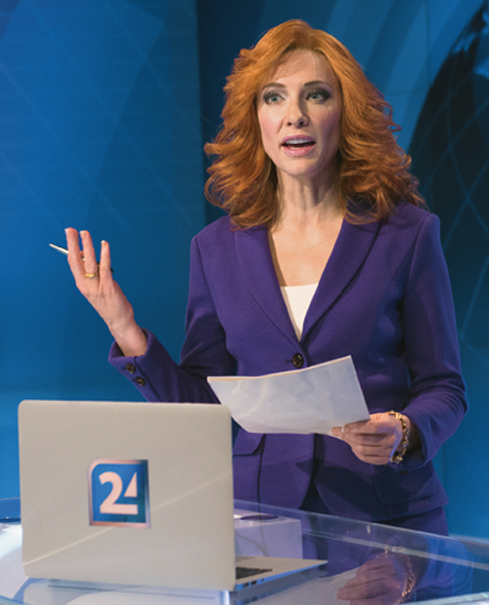
Interview with Julian Rosefeldt (extract)
By Sarah Tutton and Justin Paton
To give visible action to words
Anna-Catharina Gebbers and Udo Kittelmann
Huesos Dada
Paul Auster
Manifiestos argentinos. Políticas de lo visual 1900-2000
Rafael Cippolini
Manifesting the Manifesto: Why One Genre Has Been Ignored
Leslie Heme
The Manifesto. Negotiating Reality
Nanna Katrine Bisbjerg
Movimientos: Futurismo; Vorticismo; Jinete Azul; Expresionismo Abstracto
Movimientos: Estridentismo; Creacionismo; Suprematismo
Movimientos: Pop Art; Merz; Fluxus; Conceptualismo
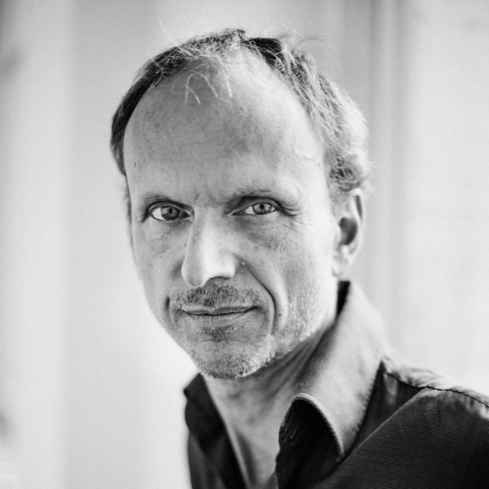 Julian Rosefeldt Ph: Veronika Bures
Julian Rosefeldt Ph: Veronika Bures
Interview with Julian Rosefeldt (extract)
By Sarah Tutton and Justin Paton
In: JULIAN ROSEFELDT: MANIFESTO, Koening Books, 2016
‘Manifesto’ is a word with a lot of historical weight. What does it mean to you?
I have used the title Manifesto as a clear statement that the focus in this work is above all on texts, whether by visual artists, filmmakers, writers, performers or architects – and on the poetry of these texts. Manifesto is an homage to the beauty of artists’ manifestos – a manifesto of manifestos.
Were manifestos important to you as a young artist?
No, I must admit that they were not important to me in the past. I simply didn’t know them at the time. Today I think of the manifesto as a rite of passage, not only for young artists but also for young people in general. As we move beyond adolescence, we leave home and scream out our newly discovered fury at the world. A manifesto often represents the voice of a young generation, confronted with a world they don’t agree with and they want to go against. You can either play in a punk band, start yelling at your parents or your teachers – or you can write or make art. Art historians tend to regard everything created and written by artists with reverence and respect, as if, from day one, the artists themselves intended their work to become part of art history. But we shouldn’t forget that these texts were usually written by very young men who had barely left home when they reached for the pen. Thus their manifestos are not only texts which are intended to turn art – and eventually the whole world – upside down and revolutionise it; at the same time they are testimonials about the search for identity, shouted out into the world with great insecurity. So I read the artist’s manifesto firstly as an expression of defiant youth, then as literature, as poetry – so to say, Sturm und Drang remastered.
The texts you have selected come largely from the first half of the last century. Why?
Yes, most of the manifestos that I have included in Manifesto are from the European avant-garde in the early twentieth century, with others from the neoavant-garde in the 1960s. The art scene at the beginning of the last century was still very small and those writers of art manifestos were again a minority within this tiny art scene. To be heard, artists needed to yell. The art scene today is a global network and business with diverse means of expression. The manifesto as a medium of artistic articulation has become less relevant in a globalized art world. You could say that the interview, the podium discussion, the talk show, the dialectically led discourse have replaced the former loud bellowing sole claim of the manifesto. It would sound unnecessarily exaggerated and almost romantic, even a bit ridiculous, to shout ‘Down with…’ or something similar today. Still, there are a few very interesting contemporary manifestos – as, for instance, the Manifesto for an Accelerationist Politics (2013) by Nick Srnicek and Alex Williams or the feminist Cyborg Manifesto (1991) by Donna Haraway – but they read more like socio-economical and -political analysis. Yet when you read a manifesto from the 1920s or even the 1960s, you still hear that original voice, that fervent desire to propel an idea into the world.
Was there a particular text that sparked your interest?
My interest in the artist’s manifesto began whilst I was working on Deep Gold in 2013. Deep Gold is an homage to Luis Buñuel’s film L’Age d’Or about two young lovers and the obstacles that prevent them from consummating their relationship. For Buñuel the lover’s predicament symbolizes the hypocrisy of bourgeois interview with julian rosefeldt Sarah Tutton and Justin Paton 97 –– Manifesto –– society, Catholicism and traditional family mores. During my research I was reading a lot about gender and feminist theory, and eventually about manifestos by feminist artists. I came across two texts by the Futurist poet and choreographer Valentine de SaintPoint. She lived an interesting life; she started out as a strong Futurist, later sympathised with fascism as did many of her Italian artist friends, and died in Egypt as a Muslim. She wrote two manifestos, one called Futurist Manifesto of Lust (1913) and the other Manifesto of the Futurist Woman (1912). They are both published in a book called 100 Artists’ Manifestos [2011, edited by Alex Danchev] which became an important source for Manifesto. When I was young I had studied – probably like everybody interested in art – Dada, Fluxus, the Surrealists and the Futurists, but only superficially. Now, during my research for Manifesto, when I read any manifesto I could find including those related to theatre, dance, film and architecture, it was exciting to discover that the same ideas appear again and again. And these common ideas all came along with so much energy – that very young, wild energy. The writing was beautiful, and I could hear the words as if they were spoken. I realised that they weren’t just historical art documents, but the most lively, performable text material. They reminded me rather of a piece of theatre, of a Sarah Kane or Frank Wedekind text or something comparable. And so I began to imagine these manifestos in performed scenes.
According to what criteria did you seek out and put together the twelve manifesto collages you created?
Before I started writing the script and collaging the manifestos, the development of the work involved a lot of textual research and analysis. With the exception of a fragment quoted from Karl Marx and Friedrich Engels’s Manifesto of the Communist Party of 1848, ‘All that is solid melts into air’, my selection begins at the start of the twentieth century with the legendary 1909 The Foundation and Manifesto of Futurism by Filippo Tommaso Marinetti and ends shortly after the turn of the century. I included Karl Marx, because for me his is the mother of all manifestos – besides the Ten Commandments and the Lutheran Thesis. The most current manifesto I used is the Golden Rules of Filmmaking (2004) by the American film director Jim Jarmusch. From all of the manifesto authors I read, I subjectively chose about sixty whose manifestos I found to be the most fascinating, and also the most recitable. Or I chose them because they suited one another. For example, the comments of Vasily Kandinsky and Franz Marc correspond extremely well with the thoughts of Barnett Newman. And also the texts of André Breton and Lucio Fontana could be linked, while the writings of the many Dada or Fluxus artists could be combined into a kind of condensation, a kind of Super-Dada- or Super-Fluxus-Manifesto. Through cuts and the combination of original texts from numerous manifestos, twelve manifesto collages finally emerged. And these read harmoniously within each collage to a degree that the borderlines between the text fragments could no longer be identified. I have constructed Manifesto as a series of episodes that can be seen separately but that can also be seen together in their entirety, as a choir of different voices. In this sense Manifesto became a new text itself – again: a manifesto of manifestos.
You have an extraordinary collaborator in all this, the actor Cate Blanchett. She inhabits thirteen different roles set against twelve different scenarios. How did these characters and their dialogue evolve?
The main idea for Manifesto was not to illustrate the particular manifesto texts, but rather to allow Cate to embody the manifestos. Until the last third of the twentieth century there were only a few manifestos written by women artists. Most were written by men and they are just bursting with testosterone. So I thought it was thrilling to let them be spoken today by a woman. The process of scripting Manifesto was very organic. I started to play with the texts and to edit, combine and rearrange them into new texts that could be spoken and performed. I like to imagine these texts as the words of a bunch of friends sitting around a table in a bar talking and arguing. They are complementing each other in a playful way. One may say ‘Down with this or that…’ and the other replies, ‘Yes, to hell with…’ I would take a sentence by one artist and interrupt it with the words of another one. Sometimes they would fit perfectly. The words took on a new energy when combined, and if you start to read the text like that it also becomes more vivid and more speakable. While in one way the process of collaging them together was maybe not very respectful to the original texts, in another I liked the way that it referenced this idea of a collection of voices, a conversation. Many of the early manifestos, of the Futurists and the Surrealists, were written by groups of artists. There were already multiple voices in these texts. I then rearranged these multiple voices from different manifestos into new monologues: in this way the authors talk to one another while, at the same time, they are addressing the audience with one homogeneous voice. In parallel, I began to sketch different scenes in which a woman talks in monologue, ending up with sixty short scenes, situations right across various educational levels and professional milieus. The only thing these draft scenes had in common was that they are being performed today, and that a woman is holding 98 –– Manifesto –– a monologue: whether a speaker by a grave at a cemetery, a primary-school teacher in front of her class, or a homeless person on the street. Sometimes we listen to the woman’s inner voice; in other instances she addresses an audience; once she even interviews herself, etc. I finally edited everything down to twelve scenes and twelve corresponding text collages. A thirteenth collage was used for the introductory film, in which we see a burning fuse in extreme slow motion. Those words that remained were simply the most beautiful, speakable and performable ones.
Manifesto was filmed over a twelve-day period in Berlin in the winter of 2014. Was there any room for improvisation?
Usually there is, but since this time we were working within a very tight time frame there wasn’t much space for improvisation. Just to give you some context, for an arthouse film you normally produce three to five minutes a day. We had to produce twelve minutes a day, which is pretty similar to the timeframe of a TV soap opera. But of course we didn’t want to work on the aesthetic level of a TV soap. So we needed a very generous team and most of all a very generous actor to work under these conditions. One challenge was the huge amount of text to be spoken in twelve different accents which Cate had to overcome. And then each of the characters had to speak in a milieu represented by the colour of speech. As if this weren’t enough, for organisational shooting reasons sometimes we even had to cover two roles per day, which also meant an additional costume and makeup change each day for Cate and the hair and makeup team. For these reasons and given the tight time schedule we had to plan the shoot meticulously. But, here and there, a certain amount of spontaneity and improvisation was necessary. And of course Cate might have read the text or understood the respective scene differently from me, and so sometimes she surprised me with ideas emerging from the depths of her profound experience and incredible talent. Every day was different, like entering Wonderland, encountering an entirely new world and character. And the way that the dialogue – or better, monologue – shaped the scene was constantly shifting and exciting. And despite the highest level of concentration and dedication, and the many working hours each day, Cate admirably retained her very special sense of humour during work. We laughed a lot.
Humour plays an important role in your work, and there is a lot of humour and absurdity in Manifesto.
It’s very difficult to purposefully create humour – as humour rather derives from spontaneity. To place a good joke in a film, the timing has to be good, and the acting as well; the absurd logic in the scene has to be convincing. Everything has to come together in that one moment, and that’s very difficult to achieve. For me, the humour in Manifesto stems from the combination of the spoken word and the scenario itself. The interaction of certain images with text fragments happened intuitively. And I find some of them funny, although it isn’t my main intention to make the audience laugh. For instance, the Pop Art scene. If you read a Pop Art manifesto you might at first come up with the idea that we need something ‘pop’, and that we might need a ‘pop’ world in which to read that manifesto. But I thought, no, actually it’s the opposite. You need a background against which the Pop Art manifesto could be written – something more like an anti-world, the fertile ground on which something like Pop Art could actually be invented. Pop Art was clearly a statement against a certain kind of stiffness in society. So I wanted to push this to the extreme and I came up with the idea of using Claes Oldenburg’s I am for an Art (1961) as the text for a conservative, religious, Southern American family saying grace before eating lunch on Sunday. I didn’t expect this scene to turn out funny in the end.
The scene set in the classroom is also very funny.
I think so too. I’m a father myself and some words of the class teacher in that scene actually reflect exactly what I would like to say to my children sometimes. And I think it resonates with us because even though we all know how important good education is, we also have this sceptical anger against so-called ‘good’ education. We hate to say ‘no’ to our children, right? And so there’s this woman in the scene, this teacher who says with utter conviction, quoting Jim Jarmusch, ‘Nothing is original. Steal from anywhere that resonates with inspiration or fuels your imagination.’ A wonderful breach of taboo. Cate does it so convincingly. And the children are so persuasive as well. If it weren’t so convincing, it would probably not be funny.
In Manifesto you have used a Sol LeWitt text about Conceptual Art for a scene in which Cate Blanchett plays two characters, a news anchor and a reporter, both called ‘Cate’. What is their relationship to LeWitt’s text?
This is an exceptional scene in a way. Rather than performing a manifesto, Cate is inhabited by LeWitt’s writing. She is the manifesto. The tussle between logic and illogic within the text is also inherent in the scene and the characters. It becomes a piece of conceptual art in a way, right?
It does. This scene is very different to the one dedicated to Pop Art that you mentioned earlier. In fact, one of the things that is so compelling about 99 –– Manifesto –– Manifesto is this diversity – every scenario is distinguished by its unique rhythm, pace and aesthetic sensibility.
Yes, I used different recipes for each scene depending on the text. The Manifesto of Futurism for instance, which is very much about speed and acceleration, is placed in the world of high finance: the fast-paced parallel world of the stock exchange where highly efficient computer programmes have let speed become invisible. So in this case the scenario depicts very much a direct translation of the original thought.
You have also used manifestos by artists such as the choreographer and filmmaker Yvonne Rainer, the filmmaker Jim Jarmusch or the architects Bruno Taut and Lebbeus Woods.
The writing in these manifestos is particularly beautiful. As an artist who studied architecture and works with film, I don’t see these disciplines as far away from painting and sculpture, anyway. I especially like the Bruno Taut piece in the collage of architectural manifestos. The architects and filmmakers caused me some trouble, though, because I’d originally wanted there to be a linear and chronological progression through the scenes combining manifestos from various creative disciplines according to the school of thought and epoch in which they were written. But in the end it felt better to keep all the architectural manifestos together, and all the film manifestos together.
That brings us to the question of actuality. In general, are these old manifestos relevant today?
Absolutely. And not just relevant, but also visionary. Art history is a derivation of history and we learn from history. Artists, as well as writers, philosophers and scientists, have always been the ones who have dared to formulate thoughts and visions whose consistency had yet to be proven. The John Reed Club of New York – named after the US-American communist and journalist John Reed – of which many artists and writers were members, published a Draft Manifesto in 1932, in which a scenario of a capitalist world order run out of control is described. It reads as if it were written yesterday. We’re well advised, therefore, to read artist manifestos as seismographs of their age.
Do you have a favourite manifesto?
Many. And now that Cate has interpreted them all, I care for them even more. The manifesto of the American artist and architectural visionary, Lebbeus Woods, of 1993, comes into my mind. It is simply beautiful: pure lyrics, beginning with the sentence, ‘I’m at war with my time’, which echoes the tenor of many manifesto texts I’ve read and used. But Woods’s manifesto ends optimistically with a line full of hope: ‘Tomorrow, we begin together the construction of a city.
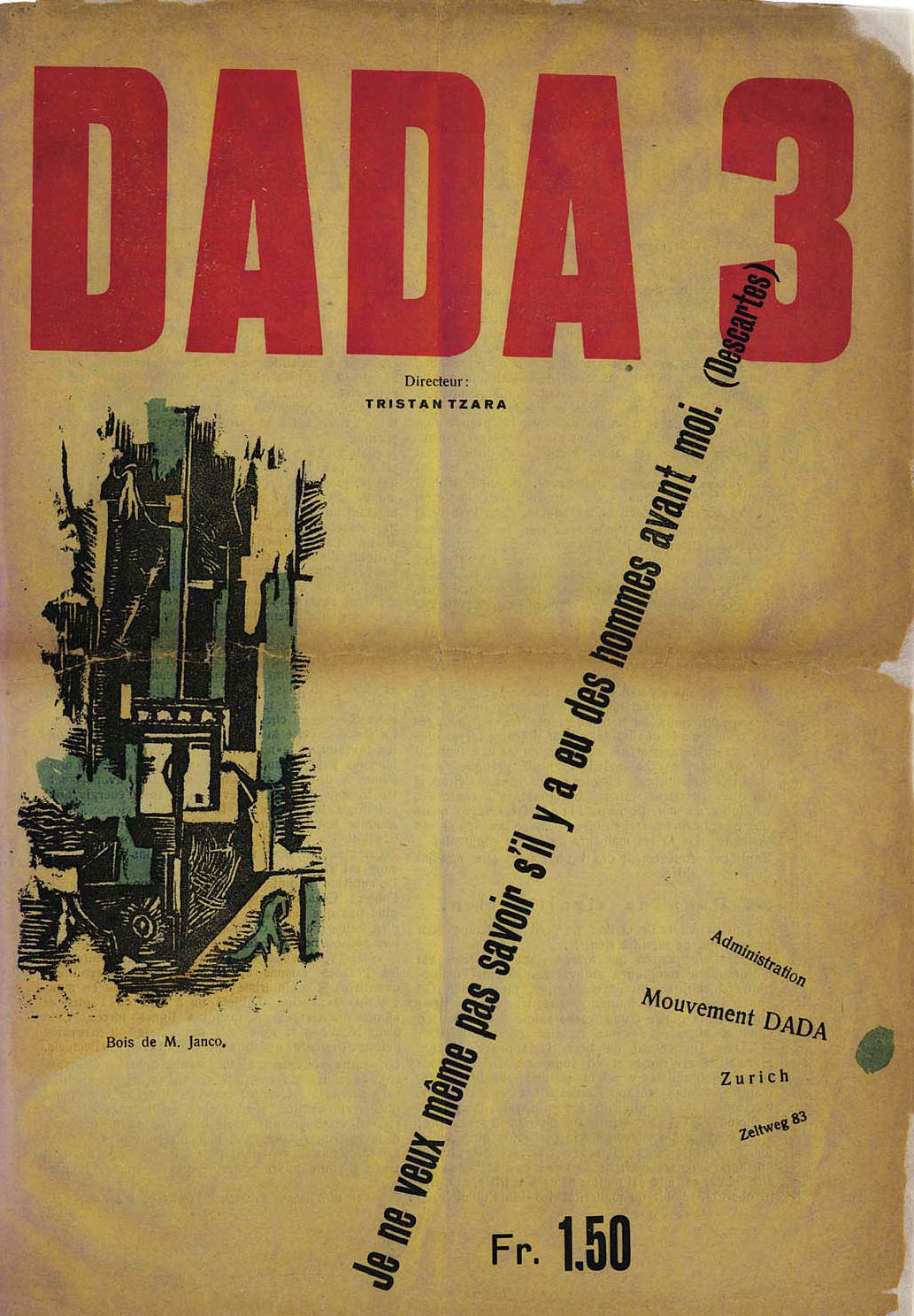 Cover of the magazine directed by Tristan Tzara
Cover of the magazine directed by Tristan Tzara
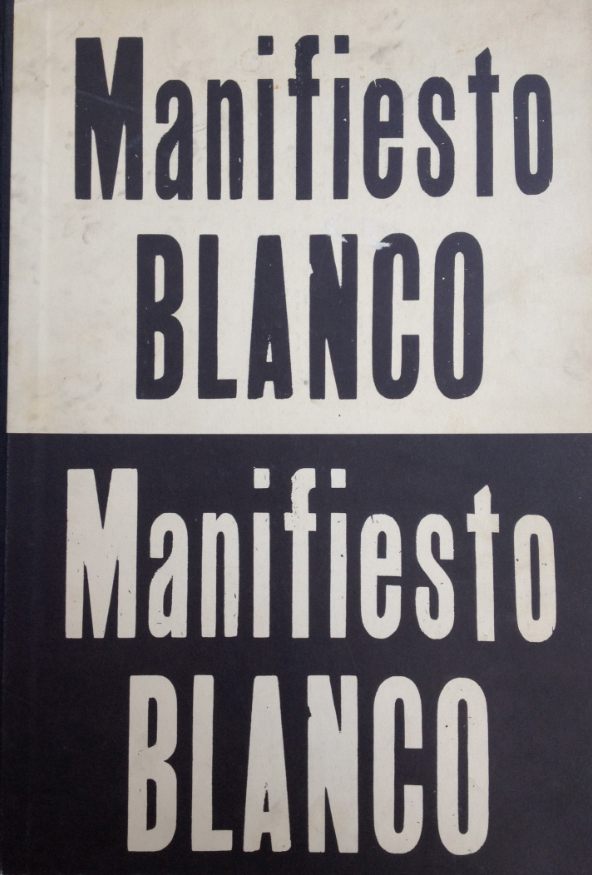 Manifiesto Blanco, Lucio Fontana, 1946
Manifiesto Blanco, Lucio Fontana, 1946
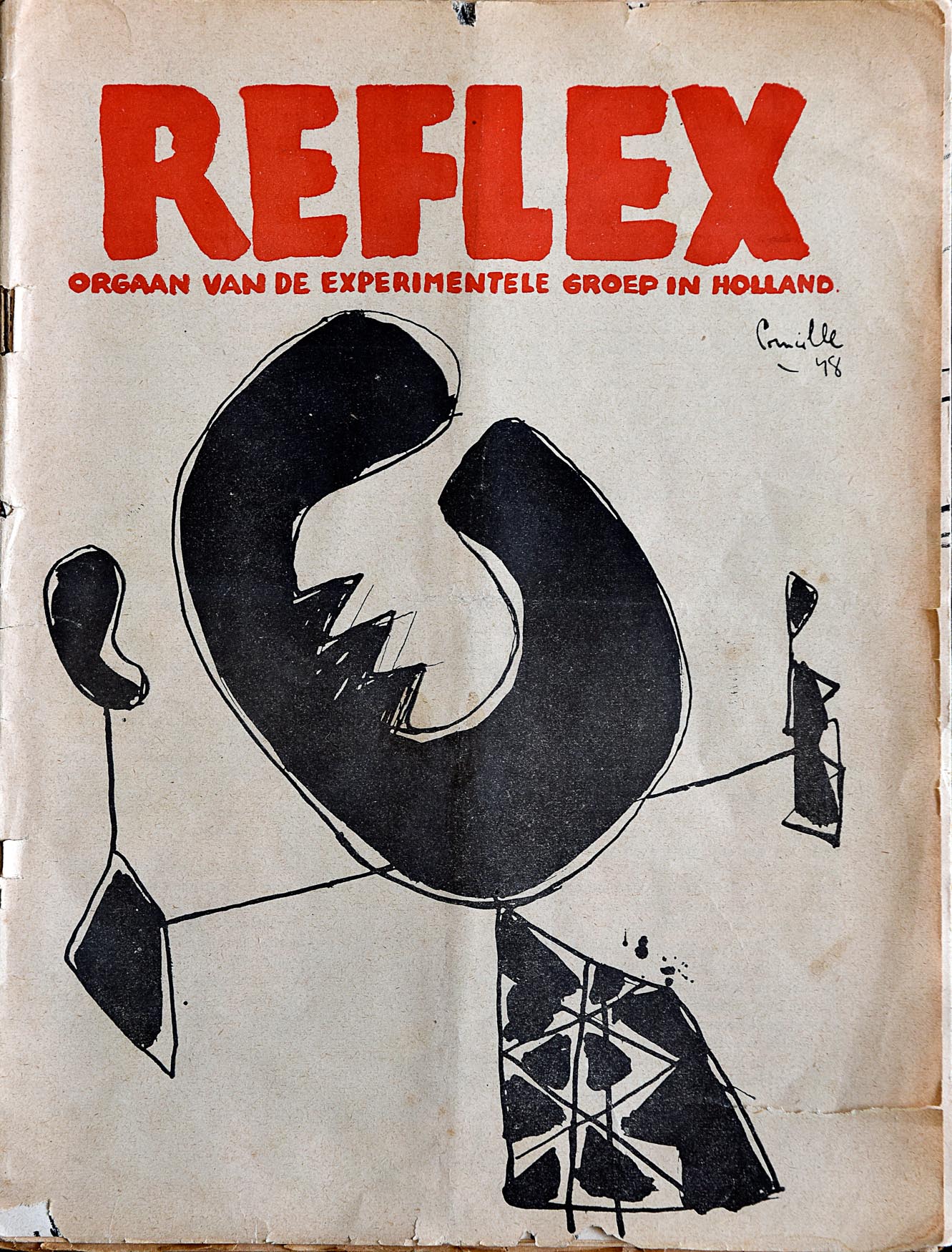 Reflex, 1948. Constant Nieuwenhuys Manifesto
Reflex, 1948. Constant Nieuwenhuys Manifesto
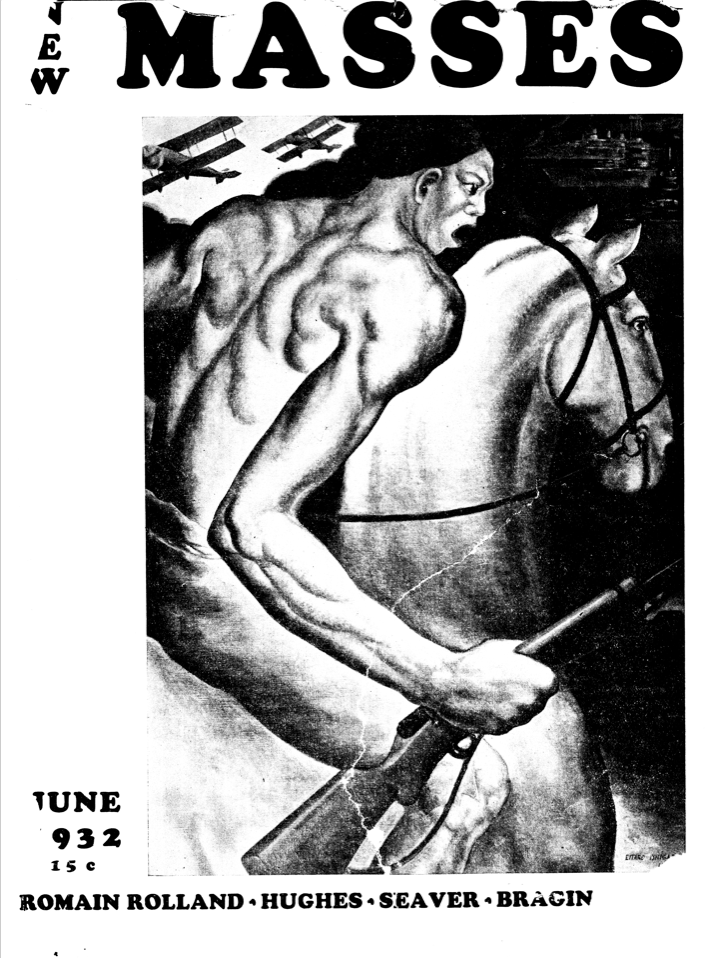 Original image of the Draft Manifesto, John Reed Club, 1932
Original image of the Draft Manifesto, John Reed Club, 1932
To give visible action to words
Anna-Catharina Gebbers and Udo Kittelmann
In: JULIAN ROSEFELDT: MANIFESTO, Koening Books, 2016
A flickering coloured shape snakes across the black screen, its pulsing light accompanied by a growing hissing noise. For the viewer, it is not immediately obvious what this encroaching object is. It turns out to be a burning fuse that Julian Rosefeldt is using to ignite his film project Manifesto. The aim of a manifesto, after all, is to demolish traditional views with an explosive force. Manifestos call for revolution and herald new eras. Along with the impetus of intentionality and performativity, a mood of departure and subversion is literally ‘inscribed’ within them, as Rosefeldt’s introductory film both reveals and obfuscates. This indeterminacy is deliberate. As the flame of the fuse gradually takes shape, enlarged almost to the point of abstraction, an off-screen voice announces: ‘To put out a manifesto you must want: ABC to fulminate against 1, 2, 3; to fly into a rage and sharpen your wings to conquer and disseminate little abcs and big abcs; to sign, shout, swear; to prove your non plus ultra; to organize prose into a form of absolute and irrefutable evidence.’
With these opening lines from his Dada Manifesto1918, the Romanian-French artist Tristan Tzara (born Samuel Rosenstock, 1896–1963) intentionally evokes associations with the avant-garde manifestos of the Futurists, among others, and plays with the blatant intentionalism of such texts. From this starting point, however, he goes on to develop a Dadaist anti-manifesto that is filled with unsettling ambiguity. His text represents an unspoken but practised antiintentionalism: ‘How can one expect to put order into the chaos that constitutes that infinite and shapeless variation: man?’3 The blurred imagery in Julian Rosefeldt’s introduction is a reference to this critique of modernity and the belief in progress that was so clearly reflected in the Futurist manifestos. Here, as in Tzara’s text, blurring is a purposeful confrontation with the world as we know it. Rosefeldt thus places his filmic blurring in the context of the avant-garde movement.
In Manifesto, Julian Rosefeldt not only examines the concerns and intentions that are so compelling and urgent they must be expressed in the form of a manifesto; he is also interested in the specific rhetoric of manifestos and how they create a ‘call to action’. This leads him to ask: what do we do by saying something? At the action level, a manifesto issues a proclamation and makes a postulation. Over and above this, however, it is intended to shape reality in a very concrete way. The connection between speaking and acting in a manifesto can therefore be analyzed both in terms of content and in relation to speech-act theory.
In a series of lectures delivered at Harvard University in 1955, which were published posthumously under the title How to Do Things with Words, the British philosopher John L. Austin (1911–1960) demonstrates that constative utterances also have a performative dimension, and that by issuing an utterance we are doing something – we are performing an illocutionary act.4 In other words: an utterance is invariably an action, and ‘with the aid of linguistic utterances we can perform a wide variety of actions’.5 Julian Rosefeldt explores this theme by developing specific links between his filmed images and the spoken manifesto texts: does a loudly or quietly spoken phrase leave a visible trace on a person’s physical actions? Is embodiment intrinsic to the text? And how do the spoken words alter the perception of the filmed images that are shown concurrently?
The introduction is the only film in this multipart work that does not feature a person on screen. Manifesto clearly wants to show individual characters with their personal struggles, their interactions with others, and their cultural and film historical traditions. And so this first glowing fuse in the darkness is mirrored in a daylight scene: on a misty morning in an industrial park, three elderly women can be seen setting off fireworks like excited young kids. The image has a distant echo of the three children playing with fireworks in Michelangelo Antonioni’s (1912 2007) movie La Notte,6 which captures the ennui of the affluent modern bourgeoisie. In the foreground of Rosefeldt’s film we see a scruffy, bearded man in a grey overcoat, dragging a shopping cart full of collected empty bottles behind him. The film then cuts back to the fireworks exploding in the sky – but now we see them from the bird’s-eye view of a drone. We look down upon the three women and the homeless man, who slowly moves off as the camera flies over the industrial park and a deep female voice is heard off-screen. The speaker is reading excerpts from texts filled with Situationist critique of elitism and capitalism, compiled and collaged by Rosefeldt from manifestos written by Aleksandr Rodchenko (1891–1956), Lucio Fontana (1899–1968), Constant Nieuwenhuys (1920–2005), Guy Debord (1931–1994) and the John Reed Club of New York (1932). In these texts, the artist is hailed as a revolutionary and demands are made to abolish commodities, wage labour, technocracy and hierarchy – life itself is to become art.
In his introductory film, Rosefeldt precedes the quotations from Tzara’s text with a line from The Manifesto of the Communist Party: ‘All that is solid melts into air.’7 This immediately creates a highly ambiguous link between the individual texts, as well as between texts and images, because for Karl Marx (1818–1883) and Friedrich Engels (1820–1895) it was clear that the bourgeoisie itself could not exist without constantly revolutionizing all relations of society. Conserving the old modes of production in unaltered form had been the condition of existence for earlier industrial classes. Everlasting uncertainty and agitation, on the other hand, was what distinguished the bourgeois epoch.
The Communist Manifesto is in fact the text that is most frequently associated with the term ‘manifesto’. Karl Marx and Friedrich Engels were commissioned by the Communist League to write this work, which was originally titled Manifest der Kommunistischen Partei [The Manifesto of the Communist Party]8 in the winter of 1847/48. When it was published in early 1848, neither the February Revolution in France nor the March Revolution in the German Confederation had yet taken place. Inspired by the spirit of Enlightenment, the ‘age of revolution’ was a period of social and political upheaval in western societies. Beginning with the America Revolution in 1776 and continuing through the French Revolution of 1789 to the Revolutions of 1848, it was succeeded by the ‘age of capital’ (1848–1875)9: following on from the uprisings against the aristocratic, feudal order, The Communist Manifesto was intended to mobilize the working class to take part in a revolutionary overthrow of capitalism.
By choosing this line as his opening quotation, Julian Rosefeldt also highlights the fact that manifestos are mainly written by young, angry men. Marx had just turned twenty-nine and Engels twenty-seven whe they demonstrated with this approximately thirtypage essay how the written word can fundamentally transform the intellectual and political world. Many of their statements and declamations have become well-known sayings, including the opening line, ‘A spectre is haunting Europe – the spectre of Communism’, and the call for action with which The Manifesto of the Communist Party concludes: ‘Working Men of All Countries, Unite!’
Following the publication of Marx and Engels’s manifesto in the mid-nineteenth century, the word ‘manifesto’ entered the vocabulary of the labour movement and became a recognized designation for this kind of text. As a generic term, however, it remained firmly rooted in political discourse. Although numerous proclamatory aesthetic texts were also written in the realm of art and literature over the years, the term ‘manifesto’ was rarely used in these contexts until the early twentieth century, when it was adopted by visual artists specifically because of its political implications. After Filippo Tommaso Marinetti (1876–1944) unleashed a flood of manifesto writing with his Manifesto of Futurism,10 the avant-garde endowed the genre with some distinctive features: the urgent and precise communication of authorial intent; appellative rhetoric; a combative, provocative style; and frequently propagandistic self-promotion.
Julian Rosefeldt recalls the proletarian origins of politicization with his highly ambiguous portrayal of a factory worker – a single mother going through her morning routine of making coffee and preparing breakfast for her sleeping daughter, and then driving to work at a waste incineration plant. It is to be assumed that these important survival rituals do not leave much room for revolutionary activities, yet while she roars through the city on her moped, texts can be heard from ambitious manifestos by architects such as Bruno Taut (1880 1938), Antonio Sant’Elia (1888–1916) and Robert Venturi (b. 1925), or the architectural studio Coop Himmelb(l)au, which was founded in 1968. Taut’s unshakable belief in the power of architecture to completely transform the world, his ‘Wandervogel’ romanticism, and his enthusiasm for the new materials of glass, steel and concrete shatter against this woman’s everyday existence, as she travels from a dreary modernist housing development to a factory where she looks out of a huge glass window onto an alpine landscape of garbage.
The first avant-garde was on the one hand closely linked to the political utopias of modernism; on the other, it aimed to integrate art into the praxis of everyday life and establish a new, revolutionary aesthetics. An integral part of this was the use of the term ‘avant-garde’, originally a French military expression denoting the ‘advance guard’ that was sent ahead of the massed body of soldiers to enter enemy territory. The new aesthetics was also characterized by its selfstaging in a variety of media, a particular rhetorical style, and the development of specific types of texts such as manifestos. Rosefeldt recalls these aspects by, for example, having an announcer in a television studio read excerpts from manifestos by Sturtevant (1924–2014) and Sol LeWitt (1928–2007) in the typical style of a newsreader. ‘All current art is fake, not because it is copy, appropriation, simulacra, or imitation, but because it lacks the crucial push of power, guts and passion,’12 she declares, quoting Sturtevant in a sharp tone of voice. During the broadcast, Rosefeldt also confronts the rhetoric of the well-groomed newsreader with her alter ego – a field reporter standing in the rain, wearing an all-weather jacket. One is enclosed within the aseptic environment of the TV studio; the other is apparently exposed to the storms of the real world (dramatically simulated using special effects, although the wind and rain machines are ultimately exposed). The field reporter and the studio anchor address each other as ‘Cate’ as they discuss the fact that conceptual art is only good if the idea is good.
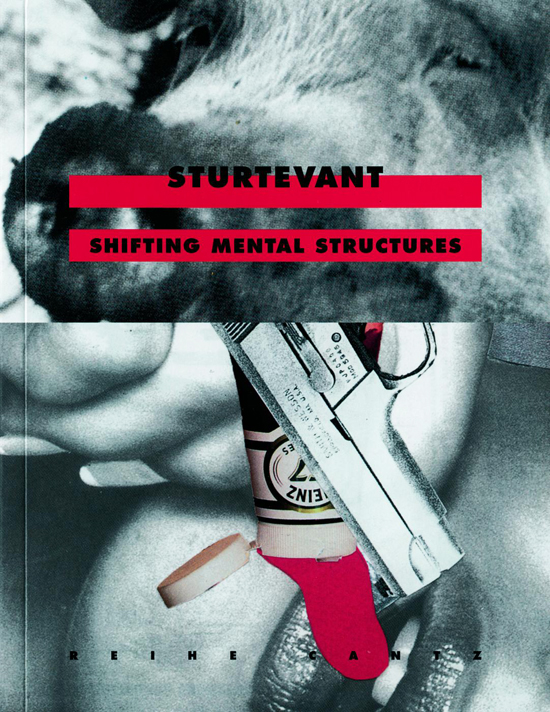
Sturtevant, Shifting Mental Structures (1999)
Manifestos are not simply a mode of providing information or giving instructions for action, however. The affirmative nature of their language, their apodictic, imperative style, their declamatory tone, the use of the future tense, hyperbole and superlatives but also the frequent inclusion of lists, memorable sequences and polar thinking are all intended to serve an appellative function. The distinctive style of a manifesto aims to create an emotional impact. Besides texts that are virtually impossible to recite, Rosefeldt has discovered manifestos with truly theatrical qualities. By taking them out of their usual context, he also draws attention to the literary, poetic beauty of numerous art manifestos by the likes of Francis Picabia (1879–1953), Bruno Taut, Georges Ribemont-Dessaignes (1884 1974), Kurt Schwitters (1887–1948), Richard Huelsenbeck (1892–1974), AndreÅL Breton (1896–1966), Tristan Tzara or Lebbeus Woods (1940 –2012). To create his text collages, Rosefeldt studies the speech rhythms of the various authors and in doing so reveals surprising parallels between them; the same musical, synesthetic approach is also used to compose his images. He links texts and images both metaphorically – for example, by establishing a connection between the manifestos of the Futurists and stock exchange traders, on account of their shared love of speed – and antithetically, when he puts Claes Oldenburg’s Pop Art manifesto into the mouth of a Southern American housewife. He also invites viewers to experiment by creating their own combinations of images and sounds as they move through the Manifesto installation. With this elaboration of the complex nature of manifestos, Rosefeldt not only gives existing texts a contemporary relevance by placing them in new contexts – a method he has already employed in other works – but for the first time he assigns the leading role to the words themselves.
As a combination of a functional text and an art text,13 the manifesto can be located ‘somewhere between literature and non-literature, poetics and poetry, text and image, word and action’.14 Tristan Tzara’s humorous interventions upset linguistic conventions and hence subvert the logic of language comprehension. The method he recommends for making a Dadaist poem involves dismantling familiar structures and developing new ones, as follows: ‘Take a newspaper. Take some scissors. Choose from this paper an article of the length you want to make your poem. Cut out the article. Next carefully cut out each of the words that makes up this article and put them all in a bag. Shake gently. Next take out each cutting one after the other. Copy conscientiously in the order in which they left the bag. The poem will resemble you. And there you are – an infinitely original author of charming sensibility, even though unappreciated by the vulgar herd.’15 Similar approaches based on deÅLcollage were later developed by James Joyce (1882–1941) and Max Frisch (1911–1991), among others; William S. Burroughs (1914–1997) and Brion Gysin (1916– 1986) used what they termed the ‘cut-up technique’. In the new millennium, this practice is also found in the realm of music, where it is known as a ‘mash-up’. It invariably involves subverting expectations in order to move beyond normal practice in the contemporary world.
The thirteen text collages that Julian Rosefeldt has compiled from a large number of art manifestos also subvert expectations, above all through their juxtaposition with his filmed images. Here, there are no angry young men mounting the barricades or declaring their demands to a secret assembly of potential conspirators. On the contrary: the majority of the protagonists are women – often not the youngest – who are either formulating the text as an interior monologue intended only for themselves, or delivering it to an audience that expects anything but a revolutionary call to action.
Although the relationship between language and image is not always asyntopical – often a person is visible on screen as we hear their inner voice – the text and the filmed images do not appear to have the same referential objects. The texts do not specify or explain the images, and this serves to emphasize the principle of expenditure, the declamatory style and the expressionistic language that are inherent in manifestos. The effect of this discrepancy between image and language is illustrated by Rosefeldt in a scene where a schoolteacher and her pupils quote passages from manifestos by experimental filmmakers such as Dziga Vertov (1895–1954), Stan Brakhage (1933–2003), Werner Herzog (b. 1942), Jim Jarmusch (b. 1953), Lars von Trier (b. 1956) and Thomas Vinterberg (b. 1969).
Despite the discrepancy between image and text, a connection is made in the viewer’s perception of what is seen. Each of the films shows someone going about their everyday business, doing their job, engaging in their usual activities – basically ‘functioning’ in a normal situation. In the viewer’s mind, due to the intuitive association between sound and images, the monologue becomes the audible testimony of the portrayed character’s inner struggle with their particular situation, or of a conflict they find themselves in. Whether it is an inner voice or an audibly articulated one, what is being ‘discussed’ are alternative possibilities for action, but these actions are never performed. Instead, a decision is made in preparation for an action. In this way, Rosefeldt adds a level of tension that runs counter to the mainly peaceful images, generating the kind of subliminal rumblings which often lead up to the implementation of an action and put viewers on alert.
Rosefeldt uses the appellative nature of the texts to heighten this tension. The verbalizations and subsequent rationalizations that occur in a monologue generally create a certain detachment from a situation, while an interior monologue is only aimed at the person him- or herself. Here, however, although the audience is not present at the fictional level of the respective characters, viewers feel that they are being addressed and challenged due to the proclamatory style of speaking. Rosefeldt draws attention to this aspect by including – at exactly the same point in each film – a moment when the main character looks directly at the viewer and addresses him or her. Different dialects and stylistic elements, such as choice of words and sentence structure, were used to create an individual manner of speaking for each of the protagonists. By turning towards the audience in this moment of synchronicity, however, the characters temporarily put their roles aside, also in a linguistic sense: their individual monologue becomes a monotonous vocalization at a constant, predetermined pitch. As each film has its own set pitch, the combined sounds briefly produce two successive chords16 – diegetically created by the orchestral harmonization of different manifestos.
The stylistic device of the aside does not have the same distancing effect (Verfremdungseffekt) in the Manifesto films as it normally does in the theatre, however. The characters do not use the aside to comment on what is happening in the film, nor do they give us information on the relationship between things or people within the communicative frame of the narrative, nor do they make critical or insulting observations. Nevertheless, the scenic unity is threatened and the fourth wall to the audience becomes porous – the screen becomes a membrane. Strangely enough, however, the characters do not actually step outside their roles; instead, the viewer steps inside the film. The seductive power of the inflammatory texts and the sense of identification with the predominantly female protagonists have an affirmative effect that draws the viewer in.
A further level is added to Manifesto by its leading actor, Cate Blanchett. Her extreme versatility and ability to authentically convey a wide range of speaking styles and dialects enable the viewer to grasp both the variety and the unifying elements of the different manifestos on an emotional level. Over and above this, Blanchett’s international celebrity guarantees that the project will receive media attention far beyond the art audience, and thus emphasizes the work’s manifesto-like character.
As the goals of the avant-garde artists – to break with tradition and move away from the idea that naturalistic representation was art’s primary task, to unify the arts and integrate art into life – also involved communicating sociopolitical ideals, their innovative approaches required careful elaboration and explanation. They wanted art to be not only the expression of, but also the driving force behind, sociopolitical change. The specific correlation between image and text is ultimately what defines the manifesto as a medium of reception control.
Julian Rosefeldt’s complex film installation draws on Guy Debord’s concept of the ‘society of the spectacle’, where relationships and experiences are increasingly mediated by visual images. The ‘crisis of narratives’18 at the end of the twentieth century also contributed to this development. At the same time, however, the growing volume of available images and texts, along with the expansion of the pool of recipients through print media, TV shows, web-based magazines and social media platforms, has led to increasing attempts – by commercial image makers, advertising media, and political bodies as much as by artists – to control reception. The desire to communicate grows, while the individual message gradually loses its distinctive quality and impact due to the endless possibilities for reflection and dissemination. Rosefeldt makes ‘manifest’ how all of this rekindles our desire for manifestos, but also shows how curiously unreal it would seem if we were now to proclaim universal ideals in the form of a manifesto.
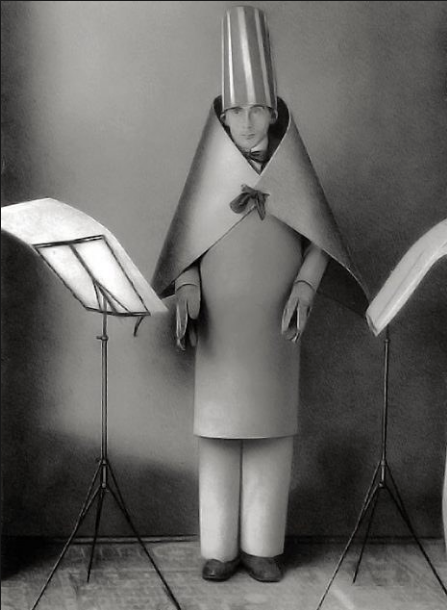 Hugo Ball reciting the poem Karawane, Cabaret Voltaire, 1916
Hugo Ball reciting the poem Karawane, Cabaret Voltaire, 1916
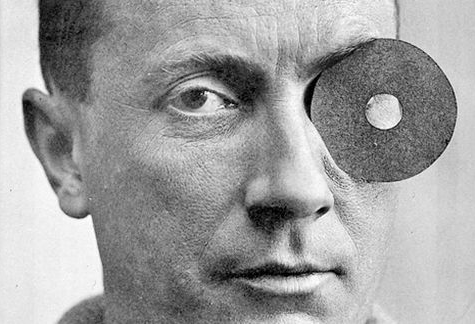 Hugo Ball
Hugo Ball
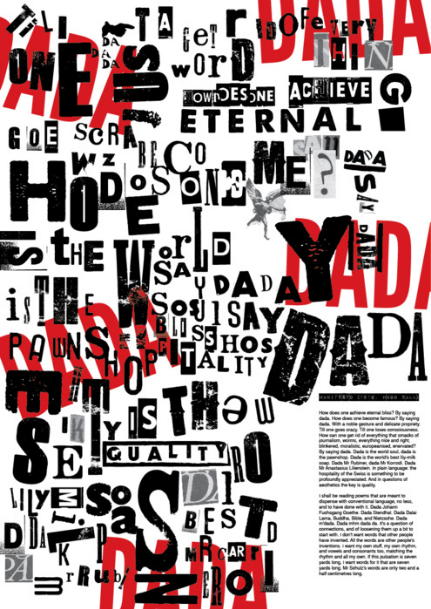 Dada Manifesto, Hugo Ball
Dada Manifesto, Hugo Ball
Huesos Dada
Paul Auster
Prologue for: Hugo Ball. La huida del tiempo (un diario) con el primer manifiesto dadaísta, Acantilado Ed, 2005. Translation by Roberto Bravo de la Varga
In: http://www.acantilado.es/wp-content/uploads/Huesos_dada_prologo_Paul_Auster.pdf
De todos los movimientos de la primera vanguardia, el dadaísmo es el que sigue teniendo más significación para nosotros. A pesar de su corta vida—comenzó en 1916 con los espectáculos nocturnos del Cabaret Voltaire, en Zúrich, y acabó, de forma efectiva aunque no oficial, en 1922 con las descontroladas manifestaciones en París contra la obra de Tristan Tzara, Le Coeur à gaz—su espíritu aún no ha quedado completamente relegado al olvido en lo remoto de la historia. Incluso ahora, más de cincuenta años después, no pasa un año sin que se publique algún nuevo libro o se presente alguna exposición sobre el dadaísmo, y es más que un interés académico lo que nos mueve a continuar investigando los interrogantes que planteó. Porque los interrogantes del dadaísmo siguen siendo los nuestros y cuando hablamos de la relación del arte con la sociedad, del arte opuesto a la acción y del arte como acción, no podemos evitar recurrir al dadaísmo como fuente y ejemplo. Queremos conocerlo no sólo por sí mismo, sino porque somos conscientes de que nos ayudará a entender nuestro propio presente.
Los diarios de Hugo Ball son un buen punto de partida. Ball, una figura clave en la fundación del dadaísmo, fue además el primer desertor del movimiento, y sus anotaciones sobre el período que va del año 1914 a 1921 son un documento extremadamente valioso. El original de La huida del tiempo se publicó en Alemania en 1927, poco antes de la muerte de Ball, a la edad de cuarenta y un años, a consecuencia de un cáncer de estómago, y está compuesto de pasajes que el autor extrajo de sus diarios editó con una visión retrospectiva clara y polémica. No es tanto un autorretrato como un testimonio de su evolución interior, una rendición de cuentas espiritual e intelectual que va avanzando de asiento en asiento de una manera rigurosamente dialéctica. Aunque hay pocos detalles biográficos, la arriesgada aventura del pensamiento basta para cautivarnos, porque Ball fue un agudo pensador (como partícipe en los inicios del dadaísmo tal vez estemos ante el más fino observador del grupo de Zúrich) y porque el dadaísmo sólo marcó un estadio en su complejo desarrollo, de modo que la visión que obtenemos a través de su mirada nos ofrece una perspectiva que no habíamos tenido hasta entonces.
Hugo Ball fue un hombre de su tiempo y su vida parece encarnar las pasiones y contradicciones de la sociedad europea del primer cuarto de siglo de una forma extraordinaria. Estudioso de la obra de Nietzsche; director de escena y dramaturgo expresionista; periodista de izquierdas; pianista de vaudeville; poeta; novelista; autor de obras sobre Bakunin, la intelectualidad alemana, el cristianismo temprano y los escritos de Hermann Hesse; converso al catolicismo, parecía que, en un momento u otro, había tocado prácticamente todas las preocupaciones políticas y artísticas de la época. Y, sin embargo, a pesar de sus numerosas actividades, las actitudes e intereses de Ball fueron increíblemente coherentes a lo largo de su vida, y al final su carrera entera se puede ver como un intento metódico, incluso febril, de basar su existencia en una verdad fundamental, en una realidad única, absoluta. Demasiado artista para ser filósofo, demasiado filósofo para ser artista, demasiado preocupado por el destino del mundo para pensar únicamente en términos de salvación personal, y con todo, demasiado introvertido para ser un auténtico activista; Ball luchó por encontrar soluciones que de algún modo pudieran dar respuesta tanto a sus necesidades particulares como a las generales, e incluso en la más profunda soledad nunca se vio a sí mismo separado de la sociedad que lo rodeaba. Fue un hombre que tuvo que afrontar grandes dificultades para lograr lo que buscaba, que nunca se fijó una idea de sí mismo y cuya integridad moral le permitió tener gestos decididamente idealistas que no encajaban en absoluto con su delicada naturaleza. No hay más que examinar la famosa fotografía de Ball recitando un poema sonoro en el Cabaret Voltaire para comprenderlo. Está vestido con un disfraz absurdo que lo hace parecer como un cruce entre el Hombre de Hojalata y un obispo enloquecido, y mira fijamente por debajo de un sombrero alto de hechicero con una expresión de incontenible terror en la cara. Es una expresión inolvidable, y esta imagen única de él viene a ser una parábola de su carácter, una perfecta interpretación del interior confrontándose con el exterior, de la oscuridad encontrándose con la oscuridad.
En el prólogo de La huida del tiempo, Ball ofrece al lector una autopsia cultural que marca la pauta de todo lo que sigue: «Éste es el aspecto que presentaban el mundo y la sociedad en 1913: la vida está totalmente encadenada a un entramado que la mantiene cautiva. […] La pregunta última que se repite día y noche es ésta: ¿existe en alguna parte un poder fuerte y, sobre todo, con elvigor suficiente para acabar con esta situación?» En otra parte, en su conferencia de 1917 sobre Kandinsky, expone estas ideas incluso con mayor énfasis: «Una cultura milenaria se desintegra. Ya no hay columnas ni pilares, ni cimientos…, se han venido abajo… El sentido del mundo ha desaparecido.» Estos sentimientos no nos resultan nuevos; confirman nuestra impresión sobre el clima intelectual europeo que se vivía en la época de la Primera Guerra Mundial y se hacen eco de muchas cuestiones que hoy damos por sentadas puesto que han acabado conformando la sensibilidad moderna. Lo que es inesperado, en cualquier caso, es lo que Ball dice un poco más adelante en el prólogo: «Podía dar la impresión de que la filosofía había pasado a manos de los artistas; como si los nuevos impulsos partieran de ellos. Como si ellos fueran los profetas de este renacimiento. Cuando hablábamos de Kandinsky y de Picasso, no hablábamos de pintores, sino de sacerdotes; no hablábamos de artesanos, sino de creadores de nuevos mundos, de nuevos paraísos.» Los sueños de regeneración total no podían coexistir con el más negro pesimismo, y para Ball no había contradicción en esto: ambas actitudes formaban parte de un mismo planteamiento. El arte no era una manera de dar la espalda a los problemas del mundo, era una manera de resolver directamente esos problemas. Durante sus años más difíciles, esta fe sustentó a Ball desde sus primeros trabajos en el teatro—«Únicamente el teatro está en disposición de conformar la nueva sociedad. »—hasta aquel planteamiento suyo, influido por Kandinsky, de servirse de «todos los medios y recursos artísticos reunidos», y más allá, en sus actividades dadaístas en Zúrich.
La seriedad con que estas consideraciones aparecen elaboradas en los diarios contribuye a desterrar algunos mitos sobre los comienzos del dadaísmo, sobre todo la idea de que el dadaísmo era poco más que el desvarío rimbombante e inmaduro de un grupo de jóvenes que rehuían la llamada a filas, una especie de chifladura deliberada al estilo de los hermanos Marx. Hubo, por supuesto, muchas actuaciones del cabaret que fueron sencillamente estúpidas, pero para Ball estas bufonadas representaban un medio para alcanzar un fin, una catarsis necesaria: «El escepticismo consumado también hace posible la libertad consumada. […] Prácticamente se puede decir que cuando desparece la fe, en una cosa o en una cuestión, esta cosa y esta cuestión retornan al caos, se convierten en mercancía no declarable. Aunque, tal vez, el caos alcanzado resueltamente y con todas las fuerzas y, por tanto, la revocación completa de la fe sean necesarios antes de que pueda triunfar una construcción radicalmente nueva sobre los fundamentos de una fe transformada.» Por tanto, para comprender el dadaísmo, al menos en esta primera fase, hemos de verlo como restos de los viejos ideales humanistas, una reafirmación de la dignidad individual en la era de la estandarización mecánica, como una expresión simultánea de esperanza y desesperación. La particular contribución de Ball a las representaciones del Cabaret, sus poemas sonoros, o «poemas sin palabras», confirma esto. Aunque desecha el lenguaje ordinario, no tuvo intención de destruir el lenguaje en sí mismo. En su deseo casi místico de recuperar lo que consideraba un habla primitiva, Ball vio en esta nueva forma de poesía, puramente emotiva, un modo de capturar las esencias mágicas de las palabras. «Con este tipo de poemas sonoros se renunciaba en bloque a la lengua, que el periodismo había corrompido y maltratado. Suponía una retirada a la alquimia más íntima de la palabra…»
Ball se fue de Zúrich sólo siete meses después de la inauguración del Cabaret Voltaire, en parte por agotamiento y en parte por desencanto con la forma en que el dadaísmo estaba evolucionando. Se enfrentó principalmente con Tzara, cuya ambición era convertir el dadaísmo en uno de los muchos movimientos de la vanguardia internacional. Tal como apunta John Elderfield en su introducción al diario de Ball: «Una vez fuera, creyó percibir una cierta “hybris dadaísta” en lo que habían estado haciendo. Había creído que estaban evitando la moral convencional para elevarse como hombres nuevos, que habían dado la bienvenida al irracionalismo como una vía hacia lo “sobrenatural”, que el sensacionalismo era el mejor método para destruir lo académico. Luego empezó a poner en duda todo esto—había llegado a avergonzarse de la confusión y el eclecticismo del cabaret y consideró que aislarse de su época era un camino más seguro y más honesto para alcanzar estas metas personales… » En cualquier caso, algunos meses más tarde, Ball regresó a Zúrich para tomar parte en los eventos de la Galería Dada y para dar su importante conferencia sobre Kandinsky, pero poco tiempo después estaba de nuevo discutiendo con Tzara, y esta vez la ruptura fue definitiva.
En julio de 1917, bajo la dirección de Tzara, el dadaísmo era lanzado oficialmente como movimiento total, con su propia editorial, manifiestos y campaña de promoción. Tzara era un organizador incansable, un verdadero vanguardista al estilo de Marinetti, y al final, con la ayuda de Picabia y Serner, fue apartando el dadaísmo de las ideas originales del Cabaret Voltaire, de lo que Elderfield denomina acertadamente «el primitivo equilibrio de construcción-negación», y acercándolo a la osadía de un anti-arte. Pocos años más tarde, se produjo una nueva escisión en el movimiento y el dadaísmo se dividió en dos facciones: el grupo alemán, liderado por Huelsenbeck, George Grosz y los hermanos Herzefelde, con un enfoque fundamentalmente político, y el grupo de Tzara, que se trasladó a París en 1920 y abogó por el anarquismo estético que a la postre desembocó en el surrealismo.
Si Tzara dio al dadaísmo su identidad, también es cierto que le sustrajo el propósito moral al que había aspirado con Ball. Al convertirlo en doctrina, al aderezarlo con una serie de ideales programáticos, Tzara llevó el dadaísmo a una contradicción consigo mismo y a la impotencia. Lo que para Ball había sido un auténtico clamor que partía del corazón contra todos los sistemas de pensamiento y acción se convirtió en una organización más entre otras muchas. La postura del anti-arte, que abrió el camino a incesantes ataques y provocaciones, era esencialmente una idea inauténtica, porque el arte que se opone al arte no deja por ello de ser arte; no se puede ser y no ser a un tiempo. Tal como Tzara escribió en uno de sus manifiestos: «Los auténticos dadaístas están en contra del dadaísmo.» La imposibilidad de establecer este principio como dogma resulta evidente, y Ball, que tuvo la perspicacia de advertir esta contradicción muy pronto, abandonó en cuanto vio signos de que el dadaísmo estaba convirtiéndose en un movimiento. Para los demás, sin embargo, el dadaísmo se convirtió en una especie de farsa que iba cada vez más lejos. Pero la auténtica motivación había desaparecido, y cuando el dadaísmo finalmente murió no lo hizo tanto por la batalla que había librado como por su propia inercia.
Por otra parte, la posición de Ball no ha perdido hoy la validez que tenía en 1917. Tal como yo lo veo, teniendo en cuenta lo que fueron los distintos períodos y las tendencias divergentes dentro del dadaísmo, el momento en que participó Ball sigue siendo el de mayor fuerza, el período que nos habla hoy con mayor poder de convicción. Tal vez sea una visión herética, pero cuando consideramos cómo se agotó el dadaísmo bajo la influencia de Tzara, cómo sucumbió al decadente sistema de intercambio en el mundo del arte burgués, provocando al mismo público cuyo favor estaba solicitando, parece que esta rama del dadaísmo debe verse como un síntoma de la debilidad esencial del arte bajo el capitalismo moderno, encerrado en la jaula invisible de lo que Marcuse ha llamado «tolerancia represiva». Sin embargo, como Ball nunca trató el dadaísmo como un fin en sí, conservó su flexibilidad y fue capaz de usarlo como un instrumento para alcanzar metas más altas, para producir una crítica genuina de su época. Dadaísmo, para Ball, era simplemente el nombre de una especie de duda radical, una manera de dejar a un lado todas las ideologías existentes y avanzar en el análisis del mundo circundante. Como tal, la energía del dadaísmo no puede agotarse jamás: es una idea cuyo momento siempre es la actualidad.
El retorno final de Ball al catolicismo de su infancia, en 1921, no es en realidad tan extraño como podría parecer. No representa un verdadero cambio en su pensamiento y en muchos sentidos puede considerarse sencillamente un paso más en su evolución. Si hubiera vivido más tiempo, no hay razón para pensar que no habría experimentado nuevas metamorfosis. De hecho, en sus diarios descubrimos una continua superposición de ideas e inquietudes, de modo que incluso durante el período dadaísta, por ejemplo, hay repetidas referencias al cristianismo («No sé si, a pesar de todos nuestros esfuerzos, iremos más allá de Wilde y Baudelaire; si, a pesar de todo, no seguimos siendo simplemente románticos. Seguro que hay otros caminos para que se obre el milagro, también otros caminos para oponerse…: la ascética, por ejemplo, la Iglesia.») y durante la etapa de su catolicismo más serio hay una preocupación por el lenguaje místico que recuerda claramente a las teorías sobre los poemas sonoros de su período dadaísta. Como señala en uno de sus últimos apuntes, en 1921: «El socialista, el esteta, el monje: los tres están de acuerdo en que la moderna cultura burguesa es responsable de la decadencia. El nuevo ideal tomará sus nuevos elementos de ellos tres.» La corta vida de Ball fue una lucha constante por lograr una síntesis de estos distintos puntos de vista. Si hoy lo consideramos una figura importante no es porque lograra descubrir una solución, sino porque fue capaz de plantear los problemas con semejante claridad. Por su coraje intelectual, por la convicción con que se enfrentó al mundo, Hugo Ball sobresale como uno de los espíritus ejemplares de nuestro tiempo.
Paul Auster, 1975
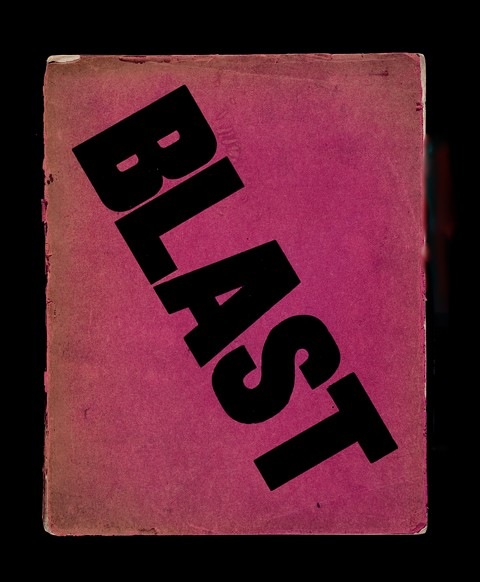 Wyndham Lewis, Manifesto en BLAST, 1914
Wyndham Lewis, Manifesto en BLAST, 1914
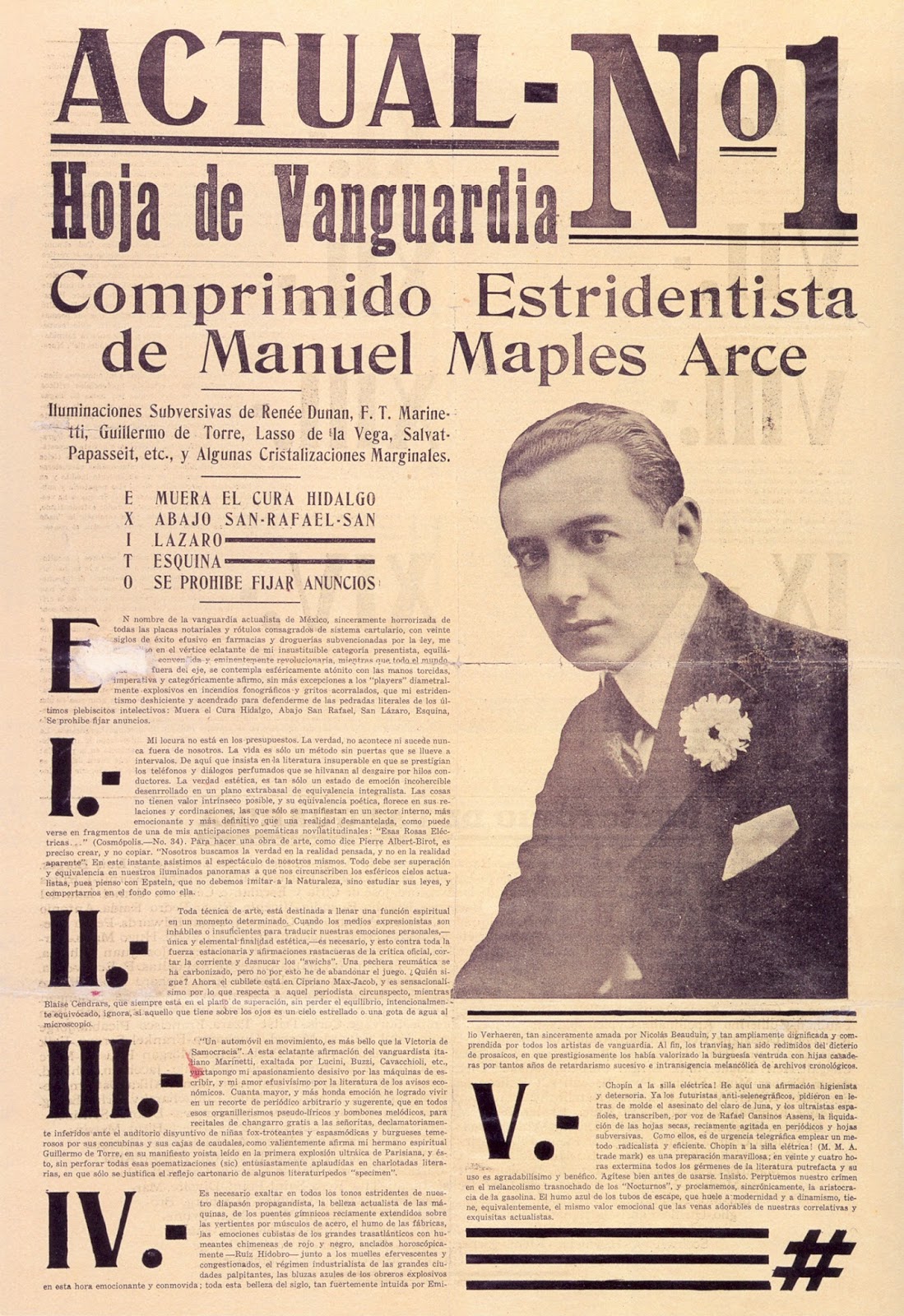 Manifiesto Estridentista, 1921
Manifiesto Estridentista, 1921
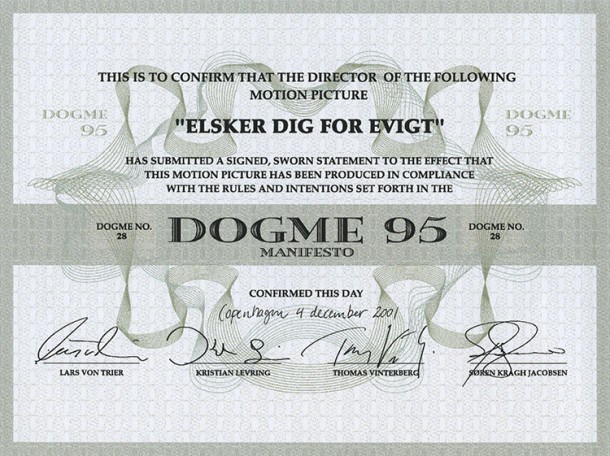 Lars von Trier / Thomas Vinterberg, Dogma 95 (1995)
Lars von Trier / Thomas Vinterberg, Dogma 95 (1995)
Manifiestos argentinos. Políticas de lo visual 1900-2000
Rafael Cippolini
En: Rafael Cippolini. Manifiestos argentinos.Políticas de lo visual 1900-2000, Adriana Hidalgo Editora, 2003
Fuente: http://www.fba.unlp.edu.ar/visuales3/material/2012_cippolini.pdf
Políticas del canon: manifiesto y legitimación
El canon es un sistema de jerarquías impulsado, históricamente, mediante diversos mecanismos de legitimación cuya forma y articulación se renueva y redefine continuamente.
Los manifiestos sostienen y socavan, admiten y destruyen la posibilidad de un canon. La noción de canon es compleja, ya que necesita e implica un conjunto de relaciones simbólicas que se extiende en la creación de su propia topología: conocemos distintos cánones, no solo temáticos (adscriptos a un orden epistemológico estricto) sino geográficos en tanto nacionales. Así distinguimos cánones locales frente a un Canon Universal que a su vez los contiene. Su otra realidad es temporal: el Canon propone ininterrumpidamente criterios de valoraci6n distintos y consagraciones diversas. Estas variaciones bien pueden denominarse «políticas del Canon".
La presencia de la mutable forma del manifiesto es uno de los principales agentes en las dinámicas de este proceso. Las estrategias de legitimación poseen efectos retroactivos: la valoración cambia su signo y los "logros" de un período histórico se revisan en otro.
De manera que, frente a la voz fuerte de un Canon se alza la voz estratégica, siempre menor e incisiva del manifiesto.
EI erudito alemán Ernst Curtius demostró lo veloz que puede resultar, en la conformación del mismo Canon, el sistema que logra que artistas y obras asciendan y desciendan mediante un remolino de fuerzas que muchas veces toma la forma de un sistema de premios y castigos.
Tal labilidad del Canon no se explica sino par su puro desplazamiento. En realidad debería entenderse como una suma de capas geológicas (más que genealógicas). De estas diferencias de identidad se aprovecha el manifiesto para provocar un orden que, si bien no siempre es nuevo, al menos, es disímil del reinante.
En el caso de las artes visuales, el Canon es una narración que se modifica, a la que se le sobreimprimen voces continuamente, formando un palimpsesto que actúa imperativamente sobre la apreciación de las imágenes que un país, región o grupo produce. EI papel del manifiesto en este relato resulta crucial.
Por lo general el sujeto del enunciado necesariamente no se corresponde con los artistas favorecidos por el Canon. Habitualmente, la buena suerte de las tentativas de la voz disidente con respecto de las operatorias de la consagración o sus beneficiarios, corresponde a aquellos que poseen un discurso textual, argumental y estilísticamente sugestivo y, en tanto, más persuasivo, mas eficaz. La eficacia se constata en sus efectos siempre múltiples.
(...)
EI manifiesto y la puesta en escena de un sujeto
La función más invariable que presenta un manifiesto es generar, inventar, poner sobre la escena un sujeto. Este sujeto es muchas veces plural y será el titular de un mecanismo (él mismo como procedimiento, una vía) de apropiación.
Un sujeto que se apropia de discursos, que utiliza la forma de saberes y aseveraciones que le son ajenas. A lo largo del siglo XX, este sujeto se presentó en múltiples aspectos y apropiándose no sólo de los enunciados propuestos en los discursos del arte, sino de la cultura universal en general.
Los manifiestos artísticos, escritos por plásticos, por artistas de la imagen, saquearon de todas las canteras: de las ciencias, de la religión, de la política, de las otras artes (muchos manifiestos presentan claros efectos dramáticos o literarios).
Uno de los primeros manifiestos argentinos sin dudas es "EI dibujo en la escuela primaria. Pedagogía. Metodología" ", publicado en 1911, y cuyo autor es eI pintor Martín Malharro. Presenta rodos los síntomas de una apropiación. Malharro se apodera de sus propios recursos: él mismo es maestro, profesor de dibujo y pintura, inspector técnico de dibujo, director de cursos temporarios de dibujo en el Ministerio de Instrucción Pública.
A su vez, utiliza todo su repertorio para intervenir ahí donde desea: la Academia, órgano que legitimaba la labor de un artista. Malharro no sólo usa la articulación de su discurso pedagógico proponiendo un nuevo método de enseñanza, sino ataca frontalmente y sabotea minucioso el mecanismo institucional que aprueba y califica el trabajo artístico.
Escritura de artista y expresiones extratextuales
Como afirma el pintor y curador Jorge Gumier Maier a propósito de la pintura, conviene parafrasearlo ahora y anotar que el manifiesto es algo que se debe sostener en cada escena, en cada aparición . Un manifiesto es una intervención, y en cuanto tal sus efectos siempre resultan focalizados y concebidos para provocar una situación determinada.
Para conseguir esa focalización presenta una escritura. El manifiesto, tal como lo concebimos, es escritura de artista. Muchas veces se denominó "manifiesto" a diferentes expresiones extratextuales. Un ejemplo sería el afiche utilizado por el grupo Ar Detroy" en 1991, titulado "Eco de silencio en el mundo", donde todo lo sostiene la imagen y no aparece palabra alguna.
Otro ejemplo, más complejo, es "el gran manifiesto -rollo arte vivo- dito" ", fechado en Ávila en 1963, obra del pintor Alberto Greco, en el cual se mixturan, en unívoca narración, dibujos en tinta, collages y textos manuscritos deliberadamente fragmentarios y autorreferenciales. En este caso, la escritura de Greco se potencia con las imágenes que la acompañan. De rodas maneras, este es un caso bastante atípico.
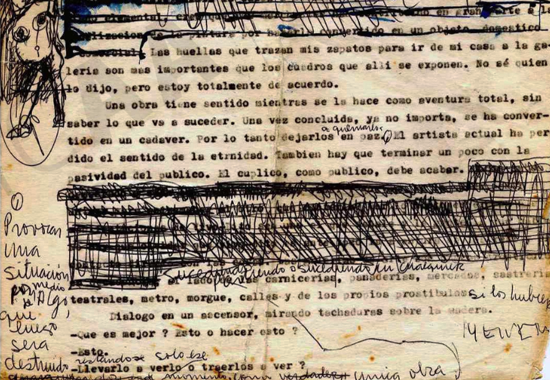
Alberto Greco, “Manifiesto Vivo-Dito del Arte-Vivo,” 1962
EI manifiesto, entonces, es una forma de escribir y de hacer pública esa escritura, de presentación de un artista visual en tanto escritor (por supuesto, en muchas ocasiones también como diseñador, diagramador y tipógrafo). EI manifiesto, además de hacer pública una escritura, prepara la puesta en escena para esa escritura.
La escritura, como herramienta, tiene aquí la finalidad de provocar.
Provocar al discurso del arte vigente, a las formas presentes de promoción y legitimación. Ahora bien ¿quién genera ese discurso del arte? ¿'Cuáles son las fuentes de esa producción? ¿Cómo, con qué, desde dónde se construye? ¿Las escuelas? ¿Los críticos? ¿Otros artistas, establecidos, más reconocidos?
Los manifiestos centran su objeto en la construcción del enemigo: en los profesores, en los críticos en tanto creadores y difusores de ese discurso que se pretende intervenir, en el gusto de la sociedad en su conjunto (es muy común que un manifiesto ataque la conformidad de un gusto establecido para generar un descontento que obligue a reformular las leyes de aceptación de una estética determinada).
Para lograr su fin el artista se convierte en crítico, es decir, utiliza la palabra, la escritura, para desestabilizar una pretensión; o bien cede la palabra a un crítico que se convierte así, momentáneamente en un artista. A veces el manifiesto es un silencio: es la sustracción, el robo del enunciado. La ambigüedad de la sentencia en (la pipa de) Magritte podría funcionar en este sentido.
Es imposible divorciar la escritura de la historia, ya que ésta (la escritura) se vuelve histórica en cada lectura. EI manifiesto tiene como objetivo un reconocimiento particular. Ninguno tiene pretensión de eternidad.
Más que sentar una posición, el manifiesto busca sentar una oposición.
Muchas veces se trata de generar un escándalo. Otras, de la emergencia de un dogma. La primera, de acelerar el caos. La segunda, de instaurar un orden: presuponer una creencia.
EI manifiesto como herramienta de exploración de la realidad
Muchas veces la emergencia de un dogma es en sí un escándalo; en medio de una situación, de un contexto caótico, el orden que intenta implementarse tendrá a futuro efectos insospechados, convocará nuevos caos. Podríamos entender como caos, en estas oportunidades, a los mecanismos de enunciado que, una vez librados a su funcionamiento, provocan los resultados mas insólitos, tanto en sus relaciones textuales como extratextuales, políticas. La escritura de la historia, muchas veces, podría definirse como un ejercicio descriptivo, basado en la narración de estas instancias. Se aplica una medida, es decir, una creencia peculiar, instrumentándola en la eficacia propia del discurso.
Una medida, lo que debe entenderse como unidad comparativa, patrón; de ella nacerá, un juego de relaciones, una referencia desde la cual tratar de entender un proceso, algunos acontecimientos.
Un manifiesto actúa sobre lo real a la vez que se convierte en una herramienta de exploración analítica de esa misma realidad. No en otro sentido jamás abandonará su naturaleza política, transformadora. Cada manifiesto resguarda un núcleo secreto de intenciones que constituyen el corazón de su capital simbólico. De ese cúmulo, de esos pequeños sistemas que llamamos capitales simbólicos, resulta imperioso trazar, provisoriamente, un boceto de arqueología.
(...)
EI manifiesto artístico como instrumento político
Lo clásico consiste en fijar la noción de manifiesto artístico como un préstamo, una transformación derivada o mera variable formal de la figura del manifiesto como instrumento político.
De esta manera se supedita la acción del arte, su campo mismo y hasta su razón de ser a la posibilidad y preeminencia de una realidad social, es decir: eI arte entendido como actividad que encuentra su especificidad en un contexto colectivo y de interpelación.
Se justifica así la necesidad política de las vanguardias: la etimología de origen y su proyecto de renovación de la vida humana como síntoma.
En cuanto a su constitución, la sumatoria de elementos parecería confirmarlo: una primera persona plural, la voluntad de ganar aliados para una causa, su exhaustividad persuasiva, el cuestionamiento de un estatuto tomado como regulador de causas y efectos.
Este esquema tradicional y político en su sentido más lato, deja consignada de una vez y para siempre la inevitabilidad de una causa determinante. Ésta será eternamente la misma, la transformación social, la diatriba del artista en el cuestionamiento de diversos factores de malestar colectivo. Esta causa excedería el ámbito de praxis del artista o bien entendería a este mismo ámbito como la atención dirigida en unívoca dirección: en las peculiaridades de la vida de relación.
El manifiesto artístico, según esta creencia, carecerla de lábiles márgenes de ductilidad formal y se ajustaría, en permanencia histórica, a un mismo prototipo ajustado y desajustado por levísimas variantes de una política vinculada a determinaciones estatales.
Desde los tramados de lectura de este libro, una de las intenciones es proponer un estado de cuestión diverso y nuevas especulaciones en torno a la determinación de una causa única y definitiva, instalada estructuralmente casi como imposición de una verdad indiscutible y mistificante.
Por el contrario, vaciando de antemano y cuestionando esta causa única, insistiendo en la naturaleza del manifiesto de artista como obra, el repertorio exhibido puede leerse en un horizonte muchísimo menos acotado, menos imperativo, participante del espíritu lúdico, libre, irresponsable, nunca esclavo de los caprichos de la grey, de la arenga de creer conocer de antemano todas las necesidades de una colectividad.
Por mera contraposición, la emergencia de diversas variables en la formalidad de los manifiestos sugiere la hipótesis de que éstos, como producción textual, intentan descubrir diferentes jerarquías atenidas siempre a diversos órdenes de necesidad.
Siendo as! posible descubrir, incluso inventar, nuevas necesidades, la idea de hombre, la definición de éste como sujeto, se libera de la sumisión de ser mero factor de obediencia a un repertorio anterior. Dado que el hombre, como tal, puede redefinir su condición en amplitudes casi inimaginables, sus instrumentos de expresión pueden mutar y reinventarse continuamente.
Como se lee, el atomizar la posibilidad única en la causa del manifiesto artístico, constituye todo lo contrario a su despolitización. Muy por el contrario, bien debe entenderse como una nueva politización, como la radicalidad de su objeto. Como la negativa a aceptar la tesis por la cual el arte en tanto actividad, en cuanto productor de realidad, no es otra cosa que un epifenómeno de lo político a secas.
El arte genera sus propias políticas en tanto indaga la novedad de otras necesidades. El arte no necesariamente es un producto social, sino que, no sólo posee un objeto autónomo inspirado en la libertad esencial del individuo, en sus sueños, pensamientos, percepciones y emociones no legisladas de antemano por orden alguno, sino que también en muchas oportunidades ha sido el mismo arte el que se adelantó, en su red de visiones y procesos, a síntomas que disciplinas como la sociología, la antropología, incluso la filosofía y la historia leyeron en absoluto destiempo.
He ahí su capacidad de vanguardia.
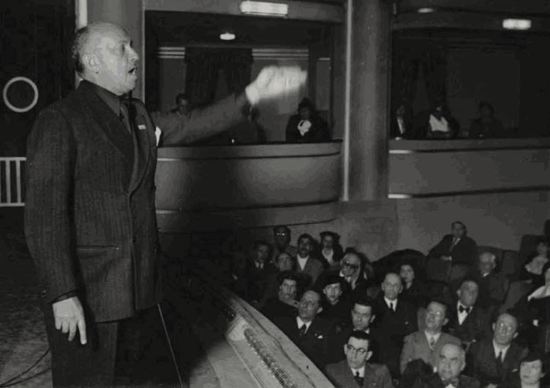
Marinetti hablando sobre el poeta-soldado en el Teatro Politeama de Buenos Aires
La idea de una vanguardia artística de status independiente es propia del siglo XX. Su promotor fue el poeta italiano Filippo Tommaso Marinetti quien, el 20 de febrero de 1909, publica en Le Figaro de Paris, un texto titulado "Fundación y manifiestos del futurismo".
EI manifiesto propiamente dicho consta de once ítems, de una introducción en clave narrativa y de una conclusión conceptual de base programática.
Este texto, de inmensa repercusión, señala una diferencia sustancial: es el arte el que genera y propone un disturbio social y político cuyas metas coinciden con un violento cambio de percepción. Su obertura se escenifica como la puesta en relato de un mito de origen: el poeta y líder, junto a sus amigos, habiendo "pisoteado largamente sobre opulentas" alfombras orientales" "discutiendo ante las fronteras extremas de la lógica y habiendo "ennegrecido mucho papel en escrituras frenéticas" "cubierto el rostro del buen fango de los talleres -empaste de escorias metálicas, de sudores inútiles, de hollines celestes" "contusos y con los brazos vendados" dictaron la Primera Voluntad a todos los hombres "vivos" de la tierra.
Su estilo es vigoroso y épico:
(..) ¡Vamos amigos! Finalmente, la mitología y el ideal místico han sido superados. ¡Estamos a punto de asistir al nacimiento del Centauro y pronto veremos volar los primeros Ángeles!. ... iHabrá que sacudir las puertas de la vida para probar sus goznes y cerrojos!' .. iPartamos! iHe aquí, sobre la tierra, la primerísima aurora! iNo hay nada que iguale el esplendor de la roja espada del sol, que brilla por primera vez en nuestras tinieblas milenarias!
Entre sus premisas se han inmortalizado:
1. Nosotros queremos cantar el amor al peligro, el hábito de la energía y de la temeridad. (..)
4. Nosotros afirmamos que la magnificencia del mundo se ha enriquecido con una belleza nueva: la belleza de la velocidad. Un automóvil de carrera con su capó adornado de gruesos tubos parecidos a serpientes de aliento explosivo ... un automóvil rugiente que parece correr sobre la metralla, es más bello que la Victoria de Samotracia. (..)
9. Nosotros queremos glorificar la guerra -única higiene del mundo-, el militarismo, el patriotismo, el gesto destructor de los libertarios, las hermosas ideas por las cuales se muere y el desprecio por la mujer. (. . .)
10. Nosotros queremos destruir los museos, las bibliotecas, las academias de todo tipo, y combatir contra el moralismo, el feminismo y toda cobardía oportunista o utilitaria.
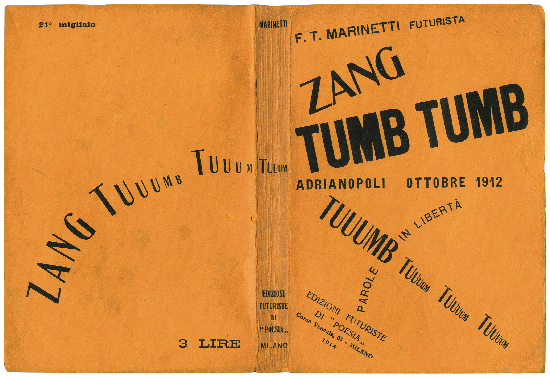
Tapa de Zang Tumb Tumb; Adrianopoli Ottobre 1912; Parole in Libertá (1914)
Hay quienes sostienen que la noción de vanguardia en las artes es anterior a dicho texto. Tal confusión existe porque más de un siglo antes la política utilizó el término, tornado de la jerga militar, para designar a quienes, dentro de la conformación de las fuerzas armadas, se adelantan para la exploración y la ofensiva. Así, algunos de los denominados por Marx socialistas utópicos, formularon que, a una "comunidad de vanguardia", corresponde un "arte de vanguardia".
En tales casos, la existencia del arte es subsidiaria y dependiente de una "política de vanguardia" previa, de un proyecto social que lo antecede.
La novedad de Marinetti es que desde el arte desea cambiar tanto el presente como las formas valorativas retrospectivas.
Tanto el cubismo como el fauvismo no fueron vanguardias sino escuelas. En primer término, la influencia de éstas se circunscribió, mayormente, al campo de las artes visuales, a diferencia del futurismo cuya pretensión fue modificar y crear, desde sus principios, multitud de disciplinas, de la música a la gastronomía. Fauvismo y cubismo fueron escuelas heterodoxas, en las cuales la idea de pedagogía, de transmisión de saber, era sobredeterminante.
La discusión es vasta. Juan Pablo Renzi publicó, en la revista Espacios, de la Facultad de Filosofía y Letras de la Universidad de Buenos Aires, n 4/5 de noviembre-diciembre de 1986, un texto titulado "Cien años de vanguardias" en el cual afirmaba:
Acordemos, desde ya, que la era moderna en pintura se inaugura con el escándalo que produjo Le dejeneur sur I'herbe de Manet en el Salón de los Rechazados de París en 1863 y que la muestra de los impresionistas en el estudio del fotógrafo Nadar, en abril de 1864, también en Paris, puso en circulación su primer movimiento de vanguardia.
Más de cien años en los que, con estupor e indignación, un público cada vez mayor ha celebrado o vilipendiado la aparición de más de treinta movimientos artísticos de vanguardia. Haciendo un promedio, podríamos decir que durante un siglo, cada tres años y fracción ha habido una nueva propuesta estética para el arte de Occidente. Dando apenas el tiempo necesario para respirar y opinar, el movimiento moderno se convierte en el proceso más rico y contradictorio de la historia de las artes visuales.
Renzi alude a una concepción amplia, la misma que utiliza, por ejemplo, Cyril Connolly en sus reflexiones y catálogos sobre el Movimiento Moderno.
EI Movimiento Moderno comenzó como una revuelta contra los burgueses en Francia, los victorianos en lnglaterra y los materialismos de Estados Unidos. EI espíritu moderno fue una mezcla de ciertas cualidades intelectuales heredadas de la llustración: lucidez, ironía, escepticismo, curiosidad intelectual, combinada con la intensidad apasionada y la sensibilidad exaltada de los románticos, su rebelión y sentido de la experimentación técnica, su conciencia de que vivían en una época trágica.
Se ha dicho que una de las funciones del manifiesto consiste en poner en escena un sujeto. Este sujeto, sin lugar a dudas, cumple un rol histórico como productor de enunciados. La singularidad del mismo es fundante al momento de proporcionar una lectura disímil, porque aporta otros elementos en el proceso de interpretación de la historia de las artes.
El caso de Marinetti, entonces, resulta paradigmático.
(...)
Ideologías, mercancía y mercado del arte
Uno de los grandes inventos del capitalismo es que todo lo existente, legal o ilegalmente, puede ser caracterizado como mercancía. EI siglo XX amplió los límites conocidos de este término hasta posibilidades antes inimaginables o apenas esbozadas. Así, las ideologías tuvieron, a lo largo de cien años, su valor diferencial de mercado, lo mismo que las estrategias políticas. Todo, según la óptica en cuestión, tiene un mayor o menor rédito. Las llamadas escrituras de artista de las que los manifiestos, en tanto forma, no son más que un ejemplo, no dejan de atenerse a esta lógica de evaluación.
EI mercado de arte define el juego de ofertas y demandas que las galerías de arte y casas de subastas ponen en circulación, determinando y adaptándose al consumo de coleccionistas, amantes o especuladores del arte. Pero también, y soterradamente, la palabra adquirió otros sentidos, establecidos ya no en una economía librada al flujo de capital monetario sino también simbólico.
Y si bien esta economía simbólica puede medirse en términos dinerarios, asimismo posee una independencia eidética que le proporciona disponibilidad plena en el dominio teórico.
No siempre las obras mas significativas de una época, aquellas en que pueden captarse los rasgos plenos de un período determinado y que, por lo mismo, en muchas oportunidades hacen las veces de puesta en abismo del lapso en cuestión, son las más favorecidas en la evaluación monetaria. En innumerables ocasiones éstas resultan ajenas a la promoción de los catálogos y las muestras respectivas.
No siempre los artífices de las vanguardias de las primeras décadas del siglo intentaron sustraerse de la ventaja económica que podía inclinarse en su beneficio.
En septiembre de 1918, Marcel Duchamp llego a Buenos Aires desde Nueva York, habiendo previamente realizado una breve escala en Barbados". Viajó acompañado de Ivonne Crotti (su hermana Suzanne estaba casada con Jean Crotti) y se hospedó en el Hotel Plaza. Partiría recién en junio del siguiente año.
Si bien en los meses que residió en el país se sabe que jugó al ajedrez y proyectó tres obras, un celebre ready-made titulado Intrucciones para el Readymade malhereux, un estudio para la esquina derecha inferior del Gran Vidrio (A regarder d 'un oeil) y Stereoscopie a la main, fue menos difundido que su fallido objetivo había sido intentar realizar una exhibición de una treintena de obras cubistas en una galería comercial, con la esperanza de iniciar así un posible tráfico. A sus planes se sumaba la intención de importar bibliografía ilustrativa, ejemplares de obras de Apollinaire y Metzinger que actuarían como difusoras de una tendencia sobre la que casi todo se ignoraba en el medio. EI proyecto, cuyo nombre pudo haber sido Cubify B. A. ("Cubificar Buenos Aires") resultó un rotundo fracaso.
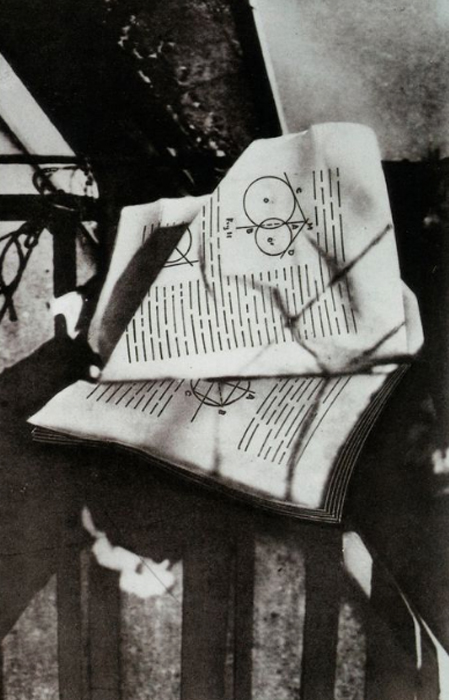
El único ready-made que Duchamp ideó en Buenos Aires fue un regalo que envió por correo a su hermana Suzanne con motivo de su boda con Jean Crotti
Cincuenta años más tarde, el discurso más visible demarcatorio de aquello que el mercado resulta para el mundo del arte seguía centrándose en una consideración peyorativa. Mientras que Romero Brest afirmaba solitariamente que era necesario un cambia drástico y puso en funcionamiento, tras el cierre del Insrituto Di Tella, una empresa dedicada al diseño, productora de objetos de uso y elementos de decoración, que se llamó "Fuera de Caja. Centro de Arte para Consumir", cuyo local funcionó en la galería del Hotel Alvear, Aldo Pellegrini escribía un manifiesto acompañando una exhibici6n de Libero Badii. Horacio Coll, Ennio lommi, Alberto Heredia y Aldo Paparella, inaugurada el 11 de junio de 1971 en la galería Carmen Waugh, cuyo título fue "El artista y el mundo del consumo":
Una de las características de la sociedad de consumo es su profundo desprecio por el espíritu del hombre, por la creación libre, por el pensamiento no sometido. EI mundo del consumo quiere aniquilar al artista porque somete el pecado de crear en lugar de consumir. El artista es un ejemplo de vida creadora. Pero en realidad toda vida auténtica es creadora. Por eso el mundo del consumo quiere aniquilar al artista porque enseña a vivir en lugar de consumir. Por eso el mundo del consumo proclama que el arte ha pasado, que ya no hay necesidad de arte, lo que tendría el mismo sentido que afirmar que ya no hay necesidad de amor y llegará el día en que también lo dirán (..) La obra del artista nos da la imagen perdida del hombre, que debe recuperarse. EI artista no os dice consumid, os dice simplemente vivid. Si abrís la puerta del artista os encontraréis en el interior de un hombre que vive. Si no respetáis la creación no amáis la vida. Quien se anima a abrir la puerta del arte encuentra la vida. Nadie debe asustarse de vivir, nadie debe temer estar vivo.
Desde entonces, ambas tendencias han subsistido con distinta suerte.
Ennio lommi, que participó de la muestra que alegaba la recuperación de un humanismo amenazado por un mundo cuyas leyes parecían dominadas por la compulsión consumista, persistió con la prédica. En julio de 1999, escribió un articulo para la revista Barbaria, difusora de las actividades del Instituto de Cooperación Iberoamericana de Buenos Aires, cuyo título es "Esto no es un país, es un cacho de tierra con gente adentro".
Uno de sus ítems rezaba:
El arte no es consumo. Es placer, idea, inteligencia.
(...)
Los manifiestos y la historia
Los manifiestos, en tanto figuras textuales e históricas, capturaron rasgos que pueden utilizarse para reconstruir y contextualizar un momento peculiar de la sociedad que los generó. Cada manifiesto, de diversas maneras, propone nuevas alternativas a la definición de aquello que puede entenderse como arte en cada período determinado.
Curiosa resulta, en consecuencia, que las vanguardias hayan puesto en cuestión el poder del lenguaje dándole al mismo, a veces simbólicamente, un poder superlativo.
Algunas de estas experiencias límite ocurrieron en el marco de lo que llamamos arte conceptual, a sea: aquel en el cual los conceptos y las palabras son el elemento plástico.
Ese territorio distinto para la circulación de las palabras a veces genera en consecuencia un manifiesto instantáneo que fija en su espectacularidad los presupuestos de un relato global. En el caso de Ricardo Carreira, la instancia de determinación temporal se presentó como un hábito distorsionado: el intercambio de unos zapatos y una expresión de deseo en el año 1968.
Quisiera poder sentir la muerte de un vietnamita como si sucediera al lado mío. La conciencia se aguanta más que un dolor de muelas. Para despertar mi conciencia yo caminaría con los zapatos cambiados de pie, para que duela y me lo recuerde.
EI texto en sí, su puesta en público, constituye un evento de disímil alcance. En muchas oportunidades, ya no se presenta (en los sesenta, contrarrestando el efecto típico de los cuarenta) como programa o proyección a futuro. sino, acorde con la tendencia a lo efímero e instantáneo, el manifiesto sirve y sirvió de encuadre a una obra. Un manifiesto para un evento (un manifiesto fungible, o sea: que se agota con el evento mismo). Esto provoca una dinámica especial, en la que el grupo de artistas que lo genera, muchas veces, no es otra cosa que la adhesión que distintos partícipes brindan a una acción individual de una obra personal. Ejemplo claro es la carta de Pablo Suárez a Romero Brest: los nombres que aparecen no hacen sino sumar sus voluntades a una protesta personal.
Otras veces, es la escenificación de una ficción especulativa. En 1990 la artista Lea Lublin realiza una obra titulada L 'acte notarié que consiste, precisamente, en una actuación notarial ante la escribana pública doctora Estela L. Antonucci, texto realizado en papel rubricado, en cuya primera página puede leerse:
"PRIMER TESTIMONIO - ESCRITURA NUMERO: DlECIOCHO - En la Ciudad de Buenos Aires, Capital de la República Argentina, a los quince días del mes de enero de mil novecientos noventa, ante mí, escribana autorizante, COMPARECE: doña Lea LUBLIN, argentina, nacionalizada francesa, pasaporte n 85 DE 50982, divorciada, artista pintora, domiciliada transitoriamente en Juncal 750, primer piso, de esta Ciudad, residente en Francia, persona hábil, mayor de edad, de mi conocimiento, doy fe y MANIFIESTA: Que en estos momentos se encuentra preparando la presentación de una serie de trabajos en vistas a realizar una próxima exposición sobre la obra del artista francés Marcel Duchamp, incluyendo el período que éste vivió en Buenos Aires, desde setiembre de 1918 a junio de 1919, para lo cual partiendo de la correspondencia enviada por el artista a sus amigos y familiares, y publicada par los archivos del 'American Art Journal', ha reunido una serie de documentos relacionados con este período, y en los cuales pudo verificar que el artista Marcel Duchamp vivió, durante su esradla en Buenos Aires, en un departamento ubicado en la calle (*) de esta Ciudad, por tal razón solicita de mí, la Autorizante, que nos constituyamos en dicho domicilio a fin de verificar su existencia y sacar fotos del lugar, para lo cual me exhibe una serie de fotocopias pertenecientes a los archivos del 'American Art Journal'."
En los párrafos subsiguientes, la notaria describe la expedición que realizó junto a la artista al domicilio porteño del creador del Gran Vidrio. Encontrado el atelier que setenta años antes había habitado Duchamp, donde hallan la ventana que inspiró la celebre Fresh Window, las herramientas estereoscópicas que él había utilizado para su pequeño vidrio, el seudónimo de Víctor grabado sobre una pared del pasillo de ingreso al inmueble y una misteriosa publicidad que anunciaba un jugo de lima de marca Rose, Lea Lublin comienza a idear, con esos indicios, un trabajo plástico en forma de investigación. L'acte notarié fue exhibida del 20 de noviembre al 30 de diciembre de 1991 en Hotel des arts & Centre Regional d'Art Contemporain Midi Pyrenees, en Francia, con el título general de Présent Suspendu. Marcel Duchamp à Buenos Aires, Objets perdus/Objets trouvés, 1919/1991, formando parte de un universo de piezas que expresaba su relación personal con la historia del arte y formulaba la intención de corregir la visión y la interpretación de los espectadores. Se trata de una labor conceptual que mezcla la elaboración de una mitología personal, apostillas al discurso histórico de las artes y un entramado ficcional donde rodo escruta, a un tiempo, uno de los rastros de origen de esta tendencia conocida también como arte de ideas o de información. La filiación es inmediata: Duchamp realizó e ideó obras conceptuales en Buenos Aires. Más de siete décadas más tarde, una artista argentina revisa el episodio, reconstruye la narración y realiza una muestra en el país de nacimiento de éste, donde ella reside.
Nos bastan estos tres ejemplos tan disímiles para preguntarnos sobre e imaginarnos qué otros sentidos capturará en un futuro incluso inmediato la noción misma de manifiesto; que increíbles mutaciones generará en cada nueva aparición; de qué manera saboteará las definiciones triunfantes de arte para instalar distintos desconciertos. Por el momento sabemos que no perderá su función crítica y que su necesidad continúa intacta. Tan es así que, podríamos arriesgar, es el arte mismo el que, en sus progresivos rasgos de síntesis y desmaterialización, adquiere particularidades y síntomas que los manifiestos nos habían adelantado.
Arthur Danto y la era de los manifiestos
Desde los últimos tres lustros del sigla XX, el manifiesto (en toda su dimensión enunciativa y formal) no es tomado, tanto por críticos como por teóricos, sólo como un mecanismo de autoafirmación de tendencia y generador de estrategias, sino en tanto un creador de horizonte histórico donde se delimita cierta capacidad de experiencia estética. Así, en After the End of Art (Antes del fin del arte, Princeton University Press, 1997), el filósofo y crítico Arthur Danto, con respecto a las narrativas histórico-críticas que dominaron buena parte de la centuria, escribió:
Cada una de las narrativas son manifiestos encubiertos, y los manifiestos estuvieron entre las principales producciones artísticas de la primera mitad del siglo XX, con antecedentes en el siglo XIX (...) Una historiadora de mi conocimiento, Phyllis Freeman, ha tomado el manifiesto como su tema de investigación, y ha desenterrado aproximadamente quinientos ejemplos, alguno de los cuales son casi tan bien conocidos como los trabajos que ellos buscaban validar. El manifiesto define un cierto tipo de movimiento, cierto estilo, al cual el manifiesto en cierto modo proclama como el único arte que importa. Es un mero accidente que algunos de los principales movimientos del siglo XX carecieran de manifiestos explícitos. (. .. ) Así cada uno de los movimientos fue conducido por una percepción de la verdad filosófica de la historia que definió el significado de la historia como un estado final que consiste en el verdadero arte.
Acto seguido, en una operación de lectura similar a la que proponemos pero con una diversa inclinación, da cuenta de la transfiguración de estas narrativas, su mudanza de sujetos y de perspectivas de sentido:
En términos de práctica crítica, el resultado es que cuando los distintos movimientos de arte no escriben sus propios manifiestos, ha sido la tarea de los críticos escribir manifiestos para ellos. La mayoría de las revistas de arte más influyentes son manifiestos escritos en serie, dividiendo al mundo del arte en el arte que importa y el resto. (..) El modernismo es sobre todo la Edad de los Manifiestos. Es propio del momento poshistórico de la historia del arte ser inmune a los manifiestos y requerir otra práctica crítica.
El manifiesto, al nominar su propia era de influencia, se convierte en una forma y proceder (artefacto de cancentración de sentida) históricos. Para Danto, el manifiesto deja de existir, pone fin a su eficacia, para dar paso a nuevas prácticas, a distintos mecanismos de generación enunciativa.
Estas políticas tienen sus antecedentes incluso en agentes filosóficos de corrientes alejadas de la promulgada par el citado.
EI pensador Gilles Deleuze, ya en 1977, declaraba:
En general un mismo falso movimiento es el que reduce la vida a algo personal, y el que presupone que la obra debe encontrar su finalidad en sí misma, ya sea como obra total o como obra en progreso que remite siempre a una escritura de la escritura. Por eso la literatura francesa abunda en manifiestos, en ideología, en teoría de la escritura, pero a la vez en querellas personales, en puntualizaciones de puntualizaciones, en complacencias neuróticas, en tribunales narcisistas.
En los anteriores Dialogues con Claire Parnet (Flammarion, 1977), Deleuze nos deja entrever que el manifiesto, como artilugio, nunca es del todo plural, siempre se cierra sobre una subjetividad que las políticas culturales y sus contextos abonan. Manifiestos, ideología, teoría de la escritura, querellas personales: si leemos la descripción como una secuencia, coincidiremos en que para revolucionar las formas enunciativas, simultáneamente deben transformarse las relaciones problemáticas de las distintas subjetividades ante las implicancias que las experiencias de la imagen promueven.
Por eso es que en este libro se suceden y descubren los efectos del manifiesto incluso fuera del manifiesto (sobre todo ahí): porque la Era de los Manifiestos que denuncia Danto sólo corresponde a un agenciamiento subjetivo, una emergencia de subjetividad específica que en su momento se llama a mutación.
Manifesting the Manifesto: Why One Genre Has Been Ignored
Leslie Heme
In: https://yadayadapourlayada.files.wordpress.com/2013/01/manifesto-essay.pdf
I started this project because I was interested in the manifesto as a text. It kept cropping up in reading assignments and research throughout my undergraduate, and now graduate, career. After some time, I began to see the manifesto as this little thing doing a whole lot of work. Namely, the manifesto seemed to be a text seeking to find a space for an author to find her/his place within a conversation, or to start a conversation where there was none. Thus, I began to do my research to explain why the manifesto has been largely ignored as a literary text worth studying. Thankfully, Galia Yanoshevsky did a large portion of my work for me. In her 2009 article for Poetics Today, “Three Decades of Writing on Manifesto: The Making of a Genre”, Yanoshevsky unearths and discusses all the criticism surrounding this critically elusive text. She writes, “…many scholars have studied its history and its general features without doubting its legitimacy as a genre of its own. Yet researchers have repeatedly complained about the neglect of manifestos in literary criticism” (Yanoshevsky 257). For me, this helped explain why I have been asked to read the manifest on several occasions; also, that there isn’t enough work done out there on it as a literary text. So, I have sent out to find out why.
What is the Manifesto?
To ask what genre is comes first. Genre is not easy to define; it is a fluid entity that floats between identity and definition—much like the manifesto. According to Ralph Cohen, Professor Emeritus of the University of Virginia and genre theory extraordinaire, “The reason a genre cannot be present in its entirety is that it undergoes change with each new genre member so that there is no ‘entirety’’ (vii). Cohen defines genre in the special edition of New Literary History solely focusing on genre theory, which takes up a group of scholars working to define genre on their separate—and collective—terms. Cohen’s “Introduction” points out that genre changes within its own conversation. He works off a statement from Margaret Cohen to describe this: “Cohen makes the point that genres ‘take shape in a generic system where different poetic patterns engage the same intractable social questions but respond to them in different ways’…” (Cohen viii). Because a genre reflects different voices, voices usually playing off one another, its form is without formation—ever fluid and ever-changing shape.
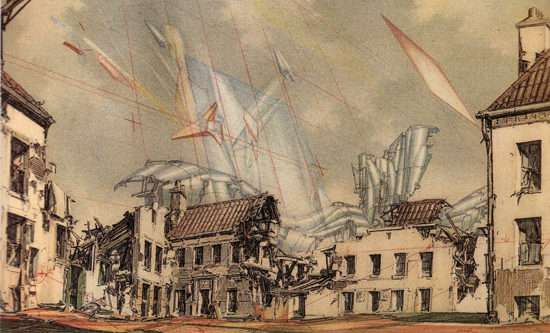
Manifiesto Lebbeus Woods, 1993
If genre is constantly moving and shifting its appearance, there is a need to understand how. Gregory Bowden discusses the significance of defining the form of genre in his research article “Radical exclusions, empty signifiers and an anti-war genre.” He says,
I quickly encountered a problem recognized by genre analysts: the indeterminancy of category boundaries. Rick Altman (1999) lists two difficulties with defining genres absolutely: firstly, we cannot determine the properties that an element must have to belong to the genre without excluding some elements that people, in practice, treat as belonging to the genre. Secondly, the elements of a genre are not necessarily exclusive to that genre alone. Any generic element may belong to multiple genres. It is this ambiguous participation and these permeable boundaries that are relevant here. (Bowden 391)
Attempting to define genre permits the ability to see it as a culmination of “elements” from other genres. There is no need to “belong” to a genre exclusively. The elements of each genre only constitute an “ambiguous participation” on “permeable boundaries.” Genre, like the manifesto, is tricky too. There is no “exclusive” genre, nor is there one way to study how it moves.
How does this relate back to the manifesto? Martin Puchner, a professor at Harvard, similarly looks at the genre of the manifesto when he discusses how Wittgenstein spent so much effort resisting the Vienna Circle’s use of the manifesto as a discourse, yet ended up writing Tractatus in the form of a manifesto anyway. Puchner states, “‘Manifesto’ is the name for the genre most clearly defined by its investment in the effects and the efficacy of its own language, and for this reason one can use it to uncover the performative dimension of the Tractatus” (Puchner 291). The point is not to focus on this specific manifesto as part of one’s research, but to notice how Puchner defines the manifesto in general. He stresses “the effects and the efficacy of its own language” as the performance behind the rhetoric. The manifesto becomes something that works from the inside out because of its very identity of being a product of language—just like other literary texts. Thus, one must read the manifesto on many levels, not one.
Since so many people believe the manifesto is solely a political discourse, it is imperative to see it as something more. As all genres are a form of social action—political in their hegemonic tendencies—the manifesto is no different. (IS THIS TRUE, LES? DO YOU EXPLAIN YOURSELF. NO. YOU MIGHT WANNA) Yet, it is a text of meta-discourse; it is a text strategically self-aware of its internal properties to effect movement. Yanoshevsky, additional to Puchner, relates to this in her article. She states,
This characteristic may account for the numerous typologies that can be found in the work on the manifesto, grouping families of polemical discourse. It also seems to be responsible for the confusion between political declarations and their literary counterparts, which runs through the work on manifestos: if the manifesto can assume all shapes and forms, then it can be political or literary as well. (Yanoshevsky 261)
To see the manifesto as a literary discourse shifts those boundaries of genre into another form—something, as just stated, genres naturally tend to do. The conversation then moves away from dismissing the political motives of the manifesto, and analyzing them as literary conventions instead.
An article of leading scholarship by Marjorie Perloff (a critic the following scholars turn to for their research in this field) establishes a new way of thinking about the genre of the manifesto. In her analysis of F.T. Marinetti’s manifesto, as well as other high-Modernists, Perloff slams a new form of the manifesto onto the researchers table: “Not exposition—the controversial statement, the daring generalization—but narrative: this invention was one of Marinetti’s master strokes” (71). Looking at the manifesto as a genre capable of literary conventions, aside from an only political register, means that it is a discourse meant to be read. (AS OPPOSED TO MANIFESTOS NOT?) Marinetti’s narrative qualities in his manifestos evokes new reception that moves away from “the controversial statement” and, instead, echoes the voice of prose. Bowden explains what this means. He says, “If genre is an open category or something to which an element can participate but not belong, how can we conceptualize it?...A category is not an objective, unchanging set; social practice produces it” (Bowden 392). Marinetti’s “social practice,” his willingness to participate in both political and literary conventions of genre manifests the manifesto into those generic elements that pull from different registers. Combing Perloff’s explanation with Bowden’s work enables the reading of the manifesto as a genre built on threads of other genres—resisting the category of it as a subgenre of literature and defining it as its very own.
The Functions of the Manifesto
Once the knowledge of the manifesto as its own literary genre becomes evident, the manifesto becomes a form based on function. William Malcuit, professor (OF?) at Loyola University, discusses the manifesto’s ability to appeal to a large audience. He states,
“The technologies of modernity and the development of modern media are largely what made this ambiguous self-positioning possible: little magazines, for example, provided the perfect forum for the propagandistic and antagonistic writings—above all, manifestos—that became central to literary production in the early twentieth century” (Malcuit 57).
 16.41.02.png)
Kurt Schwitters, The Merz Stage (1919)
The identity of the manifesto is not separate from the way it is presented—its image—but is, rather, constitute of it. By being accessible, the images of the manifesto are those subset “elements” of the genre that makes its “self-positioning possible”. This is something Cohen mandates as part of a genre: “Compositional elements”: “Every text possesses features or components that connect it with a genre, but it also includes elements such as typography, illustrations, interpretations, interventions that provide meanings beyond the formal elements” (vi). The one reason why the genre of the manifesto is hard to pin down is that it may not look like a “regular” text. Reading the non-formal elements means looking at the elements that make up the genre—meaning the aesthetic properties of the manifesto—as parts of the text.
Often enough, especially in the Modern-era, the manifesto was an undercover text cropping up everywhere in forms one would hardly expect:
“The placard, the sandwich man, the poster, the sign, the advertisement, the leaflet, the broadside, prospectus, prier d’inserer, ticket, handbill—all these methods of calling out, shouting, if you will, were devices of circumventing traditional language, imitating the sound of speech, and hence restoring to a kind of primacy, the original spoken rhythm which had been for millennia abstracted by written language.”
(qtd. in Perloff 77)
What appear to be subtexts, minor scraps of texts, are literally discourses in it of themselves. Each has these moments of identity placement and information headings guiding participation in the imitation of discourse. Perloff goes on to mention that titles and subtitles can also become manifestory subtexts to convey meaning through language: “To be memorable, Marinetti posited, a title must be concrete and provocative enough to catch the eye as well as the ear” (Perloff 77). Therefore, the aesthetic of the manifesto relies on those non-formal elements of its form to play off classic rhetorical registers like sound; the manifesto impacts discourse through the additional function of oration, proving that the more elements employed, the better.
Sometimes the images are in the presentation, or form of the discourse, and other times they are more imbedded, compositional elements. Perloff extends the course of analyzing the manifesto down to basic lexical structures like pronouns. She says,
But these images do not point inward to the self; they reflect neither inner struggle nor the contours of an individual consciousness. On the contrary, Marinetti’s selfhood is subordinated to the communal “We” (the first word of the manifesto), addressing the “you” of the crowd, the mass audience whom he hopes to move as well as to delight. (Perloff 72)
For the writer of a manifesto, utilizing precision (a word Perloff emphasizes Marinetti’s use of) evokes participation from the “mass audience” in order for the genre to move. This attention to lexical dynamics shows whose participation the author asks for, and what they are required to do: move. Much of what makes the manifesto encourage its readers to participate, or at least remember, is the form of the sentences. Puchner’s analysis shows one compositional element of syntax:
This rhetoric informs the Tractatus, most clearly so in its staccato rhythm, which is that of a hammer hitting in sentence after sentence, nailing down point after point. This rhythm and tone becomes audible by analyzing the Tractatus through a kind of reader response criticism, gauging the experience of having to jump from sentence to sentence, taking in all those absolutist claims, commands, and polemical directives one after the other without transition or explication. (Puchner 293-4)
In this way, the audience/reader participation is nearly passive; the statements hit them, giving them no time to reflect. All the reader can do is take each one in, and move on to the next. However emphatic this seems initially, it allows for participation. Puchner calls this emphasis out as a lead in. He says, “Due to its orientation toward action, the manifesto is impatient with ‘talk’ and privileges action, it is a genre intent on changing the world rather than just interpreting it” (Puchner 297). Giving the audience little time to “talk” back before reading the manifesto is finished justifies the “action” that is “intent on changing the world” after it has been read. Movement can occur once the passivity is over.
For the reader, knowing how to move is often ambiguous. The conversation between the author and the audience must be recursive. Maegan Parker utilizes the significance of why James Forman’s “Black Manifesto”—a spoken text that called for its white audience to experience their own oppression by becoming slaves—failed. She takes up the presence of ironic registers imbedded in the “Black Manifesto” to discuss how the manifesto is dependent on audience participation. Parker argues,
“The rhetorical significance of the “Black Manifesto” thus did not lie in its prophetic logic or its retributive justification, but rather in its complex ironic structuration that sought to circumvent the cycle of racial violence. To accomplish this, Forman left the tragic plot of the “Black Manifesto” unresolved, thereby enlisting the participation of his black and white auditors" (Parker 325)
The open-ended plot of the manifesto implies audience participation in order to name where the movement can go. But as she goes on to discuss, this tactic can be problematic. Parker says,“By leaving the plot of the “Black Manifesto” open for his black and white auditors’ contemplation, Forman invoked emotion to elicit active participation, though he was unable to dictate the outcome of this participation” (328). Parker sees a necessary dependence on providing the audience with at least a direction for movement, if not some attempt at an answer. The “outcome” needs to be defined in some way.
Ironically, it is in the form of the manifesto that movement begs participation toward outcome. Parker continues her argument to say that the flaw may not come from the author, but the audience. She states,
Irony is found not in the relativism of the monologue, as Burke notes, but in the perspectivism that dialogue fosters, so we must account for audience reception to appreciate a text’s full ironic range…This negative reception might be the result of an unproductive combination of ironic registers, which worked for some black audiences, but not for most whites. If, however, considering the ironic text as part of a dialogue also entails paying attention to the substance of audience responses, then this critical consideration should imbue the audience with a degree of accountability for the productivity of the encounter. (Parker 337-8)
By holding an audience accountable to the interaction they have with the text, function signifies involvement in conversation—knowing one’s place in a “dialogue”—to invoke movement. The audience must take up participating with the text. Again, passivity can only occur during the interaction, but action must take the lead thereafter.
Since the author wittingly initiates the conversation, the need to have done her/his work in the field becomes mandatory; one must know the conversation to write into the conversation. Yanoshevsky regulates the author of the manifesto to the top the hegemonic order of its genre. She asserts,
Lastly, the manifesto may be viewed as a programmatic discourse of power because it aspires to change reality with words; the manifesto is a discourse where knowledge is asserted rather than developed because used by the person who utters it as a revolutionary tool representing his or her discovery of knowledge: “The author of a manifesto sees himself first and foremost as a researcher, an inventor, a discoverer. (Yanoshevsky 264-5)
Calling the manifesto “a programmatic discourse of power” places the author at the top of the hegemony because of her/his establishment of the conversation. If the author has done the work in the field, the function of the manifesto will be as apparent as the form. S/he has established the assertion, leaving the movement up to the people, so to speak. Whereas this statement is so profound, and encompasses so much possibility, Yanoshevsky holds back one crucial point here; since the manifesto is a genre, and dependent on readership, there needs to be criticism mitigating the line between the two.
The Reason to Study the Manifesto
How does a critic begin to participate in a conversation with an author and an audience? Like all other forms of literature, the critic listens to the conversation that has taken place. Bowden’s own participation in a conversation on generic forms points to a place of entrance:
One would have to speak with the artists, distributors, audiences, and users of this poster, to see whether they consider it part of a particular genre, and why. Analyses of content and reception play a fundamental role in the social production of genre; what is at stake here is an exploration of structural properties of categorization or genre that may complement those approaches. (396)
Analyzing those “structural properties” discussed earlier provides a place where a critic can come in as part of the conversation. The critic, then, “complement[s]” the discourse, by bridging the gap of communication between author and audience, “content and reception.” This establishes the manifesto as a genre, and a discourse meant to be studied and talked about, not to only do the talking.
Talking about the aesthetic properties of the manifesto directly relates to the manifesto itself; it is a co-dependent companion to the generic form that has its own significant implications. Perloff explains,“For the real point is that theory, in Russolo’s as in Marinetti’s manifesto, is the practice that the text foregrounds what Giovanni Lista calls ‘the problematic of the precedence of project to work, of metalanguages to creation’ (Lista, p. 103). To talk about art becomes equivalent to making it” (74). Since the conversation is as much a part of the genre as the original discourse, the hegemonic order of the manifesto places the critic next to the author, not below. Studying the manifesto means coming at it like a researcher. Cohen details the need for “generic analysis,” but also what kind of study to apply. Because the manifesto’s purpose has changed over time, it serves the critic right to study its “role” in literature. Cohen asks a research question to begin: “—what functions do these short genres perform especially to the longer forms of which they become a component?” (Cohen xi). Like the researcher delving into understanding the discourse on the manifesto, the critic must ask questions related to function—much like Parker asks of the “Black Manifesto.” Her own criticism reinstates the dismissed “Manifesto” into its genre because she forms a question not on form, but on function. Parker’s role as a critic means looking at the critical discourse of the manifesto in order to see the “Black Manifesto” in spite of its problematic, ironic registers.
Naturally, the resistance to embark on analyzing a forgotten text like the “Black Manifesto” is daunting, to say the least. However, it is mandatory if one is to keep spaces open in the conversation of genre. To lose these spaces means losing to the discourse of power. Cohen details this:
It is obvious that institutional authority and power can control the production of genres by punishment or threat of punishment. They can by such threats cause writers and readers to turn to so-called innocent genres. But it is also the case that writers deliberately compose in genres that resist the restraints the authorities impose. Genres are thus political or religious action. Thus the answer to the question of who decides what genres to practice is that writers, readers, critics and institutions make such decisions. (xii-xiii)
To take one’s place in the conversation—to ask a question—is more than mere participation; it is to decide and to create space. The “writers, readers, critics and institutions” are all participants in establishing space within genre. This is the source of action. None of these can do the job as individuals and keep the conversation open; it takes collaboration from all sides to break down that power—sometimes this means daring to move out of “innocent genres” and into more politically driven ones like that of the manifesto.
What the Manifesto Can Accomplish that Other Genres Cannot
The complexity and intensity of the manifesto as a genre makes the manifesto unique in its function of movement. Looking at Perloff’s analysis of the genre initiates this appeal. She states, “Manifesto art thus paves the way for the gradual erosion of the distinction between ‘literary’ and ‘theoretical’ texts—an erosion not nearly as recent as current polemic would have us think” (Perloff 93). The capacity of this genre is compelling; the manifesto breaks down boundaries, binaries and “distinction” as a means of dispelling power, and as a mechanism for reinstating new venues of potential. She goes on: “Such calls for freedom, for the necessity of inventing a New Art, go hand in hand with the spread of literacy and the use of print media in the later nineteenth century” (69). Considering those variant forms of the manifesto, the function of the genre is an accessible discourse of power via literacy. Malcuit adds to Perloff’s analysis to elaborate on this shift. He says,“One way Pound did this was by reconfiguring the form of the manifesto, the most powerful tool of the Italian futurists and the other Continental avant-gardes, turning it from a tool of propaganda into a tool of pedagogy” (Malcuit 60). The function of the manifesto is one of action and instruction, both go hand-in-hand.
It is important to notice that the manifesto’s function relies on the previously mentioned classical rhetoric of speech. For as the manifesto permeates the mind via repetition and emphatic declaration, it is recursive, recalling itself from the participants as an inner discourse once the interaction has occurred (this is the end of that passivity). Malcuit credits this as an outcome of William Carlos Williams’s work: “…the poet produces free and unconstrained writings, which then somehow work their way into public language” (65). The manifesto can infiltrate on the sly in that it represents an aesthetic appeal based on its multitude of registers—one certainly being oratory. Once it makes its way into everyday “public language”, the manifesto becomes a natural utterance. Cohen adds to this, “Genres offer possibilities for the reconstitution of periods and for the understanding of ambiguities in generic concepts such as ‘novel,’ ‘literature,’ ‘culture.’ And they offer procedures for their own transformation” (xvi). The manifesto beckons adaptation and adoption into practice; it squirms into the subconscious. Whether one recognizes it or not, the manifesto is there in the mind—a text alive as an image well past the first sight of it. Those hammered sentences and its pamphlet style keeps the manifesto around, even if in dark recesses, ready to come out as spoken texts at any given time. This is a “procedure” for its “own transformation.”
The mode of social action in the manifesto’s function works toward a specific goal. Professional editor, Johanna Vondeling, tells of this: “Relatively distant from the economic and ideological constraints of mass circulation, the manifestos offered a space to interrogate and disrupt claims to truth, such as the assumption that politics and high art are mutually exclusive categories, or that form and content are separate concerns” (131). This is the place to affirm that space affords function—that lines between genres and form may not even be there. She then takes on a popular modernist movement’s view on manifesto discourse: “the Dadas contended the only ‘truths’ are the ones the artist and his audience construct; they viewed art not as the creation of beauty, but rather as a making, a mode of invention (and intervention)” (132). By being dependent on co-dependence of the “artist” and the “audience”, “truth” is a collaborative construction. The boundaries do not exist, but the interaction between participants does. And, with something as abstract as truth, it is not hard to see that the critic’s role is thusly important in helping to shape that construction.
The fact that structure plays a part in the genre, the participation of upcoming artists as critics bent on making their mark on the discourse is paramount. Vondeling’s research takes up Mina Loy, a feminist manifesto writer of the Modern-era—someone these other researchers overlook and who was ignored by her own contemporaries for literary and political reasons. Vondeling asserts, “Loy attacked the social institutions that craft artistic identity on a daily basis. Moreover, she approached those institutions as constructed and therefore mutable…Her solution, however, was more freedom, not less…” (135). Vondeling puts Loy’s work at the foreground of what makes the manifesto unique: it can take on any construction because of its “mutable” structure. Being formally evasive and fluid means that the participants in the genre have the “freedom” to rewrite it consistently. There is nothing more open than a discourse that is recursive, rewritable and revolutionary.
If there is to be some summation of the conversation over manifesto discourse, it is that the manifesto is indeed a social action, but a social action meant to continually ask how language impacts meaning. Vondeling’s scholarship takes the conversation there. She details three points of Eugene Jolas’s manifesto that “challenges assumptions of linguistic immutability”:
“Revolution of Language
(1) An attitude which regards modern language as inadequate for the expression of the changing background of the world, and which posits the necessity of a radical revision of its communicative and symbolic functions. (2) It regards both the individual creator and the collective folk speech as mediumistic instruments for bringing about the change. (
3) It envisages creative language as a pre-rational process. (Rothenberg 1974; 148-49)”
(Vondeling 132)
To approach language on these terms, as conveniently detailed by three consecutive, verbal slams, “The Revolution of Language” becomes a manifesto for the manifesto. Questioning the function of” language”, participating in the conversation, and being “creative” in one’s “process” is the mode of recursive action. There is a constant need to write manifestos for the manifesto based through (not on) its own language.
Of course, the reader—who can now freely become any, and all, of the participants in the genre through embracing the discourse—should indulge on the myriad of possibilities in engaging in the conversation. The genre requires endless participation. Bowden’s own work in questioning genre as a discourse leads to a place where perpetual dialogue can occur. He quotes,
“So too might a genre be subject to perpetual rearticulation: …the relationship between the individual text and the series of texts formative of a genre presents itself as a process of the continual founding and altering of horizons. The new text evokes for the reader (or listener) the horizon of expectations and “rules of the game” familiar to him from earlier texts, which as such can then be varied, extended, corrected, but also transformed, crossed out, or simply reproduced. (qtd. in Bowden 401)
The options exist above; Bowden names them. Manifestos embrace the dynamics of an identity without limitations. As a discourse, they perform like a function of genre, making them stylistically different than other genres in their hyper-aware properties. They pursue active questioning as a process, and as a performance. They are the things aesthetics are made of—intangible, but right in front of us nonetheless. The manifesto, thus, becomes any text where an argument is made, read (or heard), and then responded to; it is our job as rightful participants in generic creation and reconstruction to jump in all points to keep the conversation alive. This means having a voice—and using it.
Works Cited:
Bowden, Gregory. “Radical exclusions, empty signifiers and an anti-war genre.” Social Semiotics 19.4 (2009): 389-403. JSTOR. Web. 16 May 2011.
Cohen, Ralph. “Introduction: Notes Toward a Generic Reconstitution of Literary Study.” New Literary History 34.3 (2003): v-xvi. Project Muse. Web. 19 May 2011.
Hanna, Julian. “Blasting after Blast: Wyndham Lewis’s Late Manifestos.” Journal of Modern Literature 31.1 (2007): 124-135. Project Muse. Web 16 May 2011.
Malcuit, William Q. “The Poet’s Place: William Carlos Williams and the Production of an American Avant-Garde.” William Carlos Williams Review 28.1-2 (2008): 55-77. Project Muse. Web. 16 May 2011.
Parker, Maegan. “Ironic Openings: The Interpretive Challenge of the ‘Black Manifesto.’” Quarterly Journal of Speech 94.3 (2008): 320-342. JSTOR. Web. 19 May 2011.
Perloff, Marjorie. “‘Violence and Precision’: The Manifesto as Art Form.” Chicago Review 34.2 (1984): 65-101. JSTOR. Web. 23 May 2011.
Puchner, Martin. “Doing Logic with a Hammer: Wittgenstein’s Tractatus and the Polemics of Logical Positivism.” Journal of the History of Ideas 66.2 (2005): 285-300. Project Muse. Web. 16 May 2011.
Rhodes, Jacqueline. “Homo origo: The queertext manifesto.” Computers and Composition 21 (2004): 387-390. Science Direct. Web. 13 Apr. 2011.
Vondeling, Johanna E.. “The Manifest Professional: Manifestos and Modernist Legitimation.” College Literature 27.2 (2000): 127-145. JSTOR. Web. 19 May 2011.
Yanoshevsky, Galia. “Three Decades of Writing on Manifesto: The Making of a Genre.” Poetics Today 30.2 (2009): 257-286. Web. 23 May 2011.
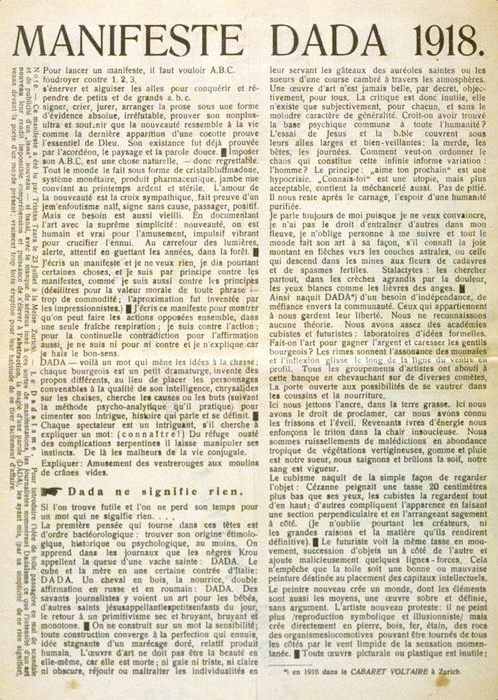 Manifiesto Dada, 1918
Manifiesto Dada, 1918
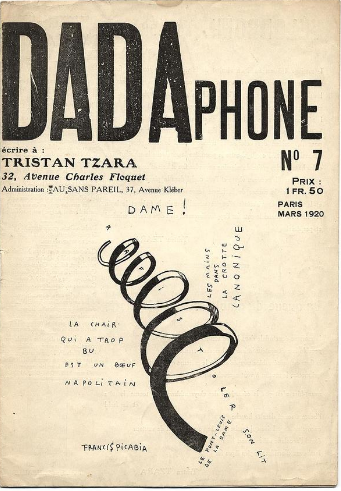 Francis Picabia, Dada Cannibalistic Manifesto (1920)
Francis Picabia, Dada Cannibalistic Manifesto (1920)
The Manifesto. Negotiating Reality
Nanna Katrine Bisbjerg
In: http://www.avantgardenet.eu/HAC/studentpapers/bisbjerg_manifesto.pdf
With The Founding and Manifesto of Futurism (1909) by Filippo Tommaso Marinetti and TristanTzara’s DADA Manifesto 1918 (1918) as cases this article will discuss the negotiations of time and history taking place in the avant-garde manifestos.
The writing, reading and proclamation of manifestos has from the very beginning been a central practice for what we today call the avant-gardes. The avant-garde manifesto is in more than one way a transgressive and transforming genre. The avant-garde manifesto places itself in between the spheres of art and theory; it is both to be seen as theory, as directions and guidelines for the future art to come, and as a work of art in itself. That is, the manifesto is both means and end, both action and goal.
The Manifesto as performative
The manifesto can be seen as an action or as a performative, since it founds the movement, and founds the “we” of the movement that it represents. The writing, reading or declamation of the manifesto is what founds the movement.
Besides the performative character of the manifesto is underscored by the fact that the manifesto was often declared from stages, as was for example Tristan Tzara’s Dada Manifesto 1918. Theoretically, the manifesto as an action, or as a performative, can be explained with the British philosopher of language J.L. Austin’s theory of speech acts presented in his book How to do things with words (1962).
Austin shows how language acts and not just says. How certain utterances are not only descriptive or to use Austin’s word constative, but actually acts, performs an action, witch directly influences the social reality. The performative or perlocutionary utterance does what it says. The manifesto is a founding and defining action. As an example of this we have these lines from The Manifesto of Futurism:
It is from Italy that we launch this violently upsetting incendiary manifesto of ours. With it today we establish Futurism.
According to Austin it does not make sense to judge the perlocutionary utterance as to whether it is verifiable or not, whether it is true or false. Instead it must be judged according to other criteria, most importantly according to criteria of seriousness. These criteria are for example; if the circumstances are appropriate, the intention of the one speaking, and if the one speaking / uttering the performative and thereby performing the action has the authority to do so.
Martin Puchner in his book Poetry of Revolution (2007) claims, that the manifesto does not fulfil these criteria since it (or the subject pronouncing it) lacks the authority it claims to posses, the manifesto does not yet posses this authority. Puchner after all grants the manifestos if not performative power then at least theatrical power. According to Puchner the manifestos assume the performative power of speech acts. They assume the authority, which they do not yet have. In continuation of Puchner one can say, that the manifesto borrows its point of enunciation, and in that way its authority, from the future. The manifesto projects itself forward in time anticipating what will have happened and speaks as if it had already happened, as if the movement was already founded, as if this we of the movement already existed and the manifesto already possessed the authority of this “we”.
Negotiations of time and history
When the manifesto is seen as an action, as a performative (or at least as a theatrical assuming to be a performative), it becomes clear, that the manifest contains as a central aspect political discussions about the experience of time and history.
It is not only in regard to to the categories of theory, work and praxis, that the manifesto places itself in between, it is also in regard to time. The manifestos are both dealing with the conception of past, present and future. They are rewriting, negotiating and subverting the conceptions of time and history, and different conceptions of time and history can be seen within a single manifesto. As an example of this and of how the manifesto projects itself or its point of enunciation forward in time, into the future, look at this part from the Futurist Manifesto:
So let them come, the gay incendiaries with charred fingers! Here they are! Here they are! Come on! Set fire to the library shelves! Turn aside the channels to flood the museums!… Oh the joy of seeing the glorious old canvases bobbing adrift on those waters, discoloured and shredded!…
Here we see a lot of the manifestos devices; imperatives, exclamation marks, the grammatical tense shifts from future to present tense. In this piece of text the actions the futurists want to make happen are happening now, they have already happened, the museums have already been flooded and the paintings are now drifting in the water.
This is an example of how the manifesto occupies the future. The manifesto writes about the future as if it had already happened, it writes about the not-yet-being, the not yet existing and in that way gives it textual form and existence in the present.
This is a way of actualizing the future, and of making a radical different future easier to imagine. Here the future is not some distant dream, it can and will happen, it is happening now!
The “now” of the manifesto
The time of the manifesto is this “now”, this moment where the future becomes actualized, a moment of inevitable action.
In its founding action the manifesto often (re)writes the history of the past leading up to this now of the manifesto; the moment of action. In this rewriting the manifesto foregrounds other things and aspects than the dominant discourse (of for example society) and shows that everything is not good, that there are injustices and other bad things going on.
Before the manifesto’s “now”, before the break with the past, it must be made clear why a radical break with the past is desired.
In the first part of The Founding and Manifesto of Futurism before the launching of the actual manifesto, Marinetti writes of the past as:
The old canal muttering in feeble prayers and the creaking bones of sickly palacesabove their damp green beards
Here the heritage from the future is portrayed as sick, unhealthy and weak, as something negative, as “a horrible shell of wisdom”iv that the futurists wants to “break out of”. And this is what they explicitly do in the launching of the manifesto, where they “affirm the new beauty of speed”, and call the museums “graveyards” and “cemeteries” and wants too flood them and to set fire to the libraries.
This part of the text is portraying the past all the way up to the now of the manifesto in negative terms. At the same time this is a creation of a mythical version of the history of the birth of the futurist movement and manifesto. This complete mythical version even contains a metaphor of rebirth. When Marinetti crashes in his car and rolls over into a ditch, it is described like this:
O maternal ditch, almost full of muddy water! Fair factory drain. I gulped down your nourishing sludge; and I remembered the blessed black breast of my Sudanese nurse.
And it is of course after being reborn, after coming out of the ditch
torn, filthy and stinking[…] faces smeared with good factory muck - plastered with metallic waste, with senseless sweat, with celestial soot [..]our arms in slings
that the manifesto is launched, that the futurists declare their “high intentions to all the living of the earth"
In the DADA Manifesto 1918 the rewriting of history is not mythical, here it becomes clear in a more directly political way why we have to break with the past. In the Dada manifesto we have criticism of religion, represented as “a crystalbluff madonna”, capitalism; “the monetary system”xi and of previous art movements’ attempts to break with capitalism and the bourgeois state of the art: We’ve had enough of the cubist and futurist academies: laboratories of formal ideas. Do we make art in order to make money and keep the bourgeoisie happy?.. Every group of artists has ended up at this bank, straddling various comets. Leaving the door open to the possibility of wallowing in comfort and food.
Dadaism puts forth a critique of the actual present society and of the other avant- garde movement’s attempts to change this society, saying that they had not succeeded in what they promised, there was no break, no revolutionary action, these movements had just been a continuation of the old. This conception of time, where the future is only being thought as, and only possible as, a continuation of the past, Janet Lyon in her essay Feminist Futural – Five Kinds of Time calls “public time” using the vocabulary Guy Debord or “general time of society” using the vocabulary of Bergson and Deleuze. This “general time of society” is a universal and unidimensional conception of time, here time is deterministic and the future can be nothing but an elaboration of the past and present.
It is to a great extent this universal conception of time that the manifestos seek to negotiate. In the manifesto's founding action, in its “now”, it establishes a new point of enunciation, a new we. This becomes a platform from where the actions of changing the future of society can start. In a society dominated by an opponent discourse that leaves no room for other voices and other conceptions this is an important first step.
Wishes for change and fears of assimilation
Regarding Marinetti one can doubt that he had any problems with a universalistic conception of the world, of history and society, as long as it was his version, his truth that was the dominant one. The “now” Marinetti establishes in The Founding and Manifesto of Futurism does make room for something new, it does establish a break. But this new we it establishes; “We the young and strong futurists” is indeed a very excluding we. It is the young and rich with time to waste, time to stay up all night, and with money to spend, money that gives access to cars and ensures it is not a big thing if a car crashes.
Marinetti stages that
When we are forty, other younger and stronger men will probably throw us in the waste-baskets like useless manuscripts –we want that to happen.
Marinetti has no problem with the fact, that the manifesto as genre is also colonizing, and that it subscribes to a universalistic conception of truth, time and history, his only problem was, that according to him it was the wrong version of truth, that is not his version, that was the dominant one.
The paradox of the manifesto, the fact that it at the same time as it challenges universalism also affirms it, because it just creates a new version (for example of a supposed universal but in reality excluding we), Marinetti did not consider a problem.
This is very different for the Dadaists. The Dada Manifesto1918 expresses a thorough rejection of universalism and its implied logic. This is clear all the way through this manifesto. Tzara starts by making ironic comments about the manifesto genre:
To launch a manifesto you have to want: A. B. & C. and fulminate against 1, 2, & 3: I am writing a manifesto and there’s nothing I want
Here Dada also negotiates the rules of the manifesto, the limits and conventions of the genre itself (which is also why the Dada manifestos are sometimes called anti manifestos). In The Dada Manifesto 1918 the opposites continue, nowhere is there a clear definition of anything. Where Marinetti in The Founding and Manifesto of Futurism (1909) used the first third part of the text to create a myth of the birth of the manifesto and movement, this Dada manifesto claims, that
DADA DOES NOT MEAN ANYTHING
And continues by listing up all the different explanations that have been given by others of the origin of the word:
We read in papers that the Negroes of the Kroo race call the tail of a sacred cow: DADA. A cube, and a mother, in a certain region of Italy, are called: DADA. The word for a hobby horse, a children’s nurse, a double affirmative in Russian and Romanian is also DADA.
Tzara continues with ironically calling the persons who try to explain the word “learned journalists”, “bourgeois little playwrights and” “jesuscallingthelittlechildrentohim saints" and thereby connecting them to old conservative institutions (“stiffened faculties”), capitalism and religion. Ideologies and institutions which for Tzara and Dada all represent universalistic and oppressing ways of thinking and acting.
Tzara continues:
a sensitivity cannot be built on the basis of a word; every sort of construction converges into a boring form of perfection, a stagnant idea of a golden swamp
Again we see the universalism and stagnation of society foregrounded, the “general time of society” is the dominant conception of time in the society Dada wants to break with.
When in the last part of the manifesto it is claimed that Dada is
the abolition of logic” of memory of archaeology , of prophets and the abolition of the future
it is exactly “general time of society”, the stagnant conception of time and history, the conception, where the future can be nothing but a continuation of past and present, that they want to abolish. In the opinion of Dada the dominant discourse of today, the way we think today only enables us to imagine the future as a continuation of the past and present and they want to abolish that. The elaboration of history following this logic is exactly what
has made it impossible for us to be anything other than impassive towards policemen –the cause of slavery- putrid rats with whom the burgeois are fed up to the teeth, and who have infected the only corridors of clear and clean grass that remained open to artists.
Whether this is a direct attack on policemen blaming them for slavery, I cannot say, but it is for sure an attack on the society they represent, a society dominated by a universalistic way of thinking, that has made us unable to see the absurdity and injustices of the world (e.g. slavery in all its forms), and to imagine the possibility of a radically different and better world.
Capacities for change? Some questions and conclusions.
But can Dada do anything more than make us capable of thinking outside the box, than make us aware of the absurdity of the world and make us wanting a radically different future? Can they and do they propose a better version of society? The Dada painter and film maker Hans Richter writes in 1964:
After Dada had proclaimed for six years that everything must be, ought to be and was being put an end to, turned upside down and left there – it put an end to itself .[..] Dada had given birth to a new way of thinking, a new attitude a new ethos .. both in art and thought . But by its very nature[..]. It could not become a discipline or a theory – not in the universe of liberty that it had itself set out to claim.
It is here that Richter sees Dadaism changing into Surrealism, he doesn’t see Surrealism as an antithesis to Dada, (- in the beginning, he says, it is very hard to tell the difference,) but the nihilism of Dada had to be extended with a theory, a goal and an orientation towards the future, a plan of action.
But with the surrealists’ launching of manifestos or more exactly with the surrealist disputes about who was allowed to launch manifestos, it again becomes very clear, that the control over the manifesto goes hand in hand with the control over the history of the movement. The dispute of the surrealist manifestos was very much about exercising this control.
If surrealism did succeed in suggesting and realizing a new society, or if, as Danish lecturer Mikkel Bolt would say, the Situationists and Situationist International were the first to conscious attempt to unite Dada’s negations with a more socially functional art, is a question I cannot discuss any further here.
What we can conclude is, that the manifestos were and are still very powerful. Especially according to the historization the manifestos were and are powerful, it is still to the manifestos we go back and in the manifestos we find our sources and support when we want to define, understand and historize the avant-gardes.
Bibliography
• Austin, J.L.: How to do Things with Words, Oxford University Press 1976 • Bolt, Mikkel: Den uundgåelige opløsning af afsavnets verden. Situationisterne som manifestskrivere Kultur & Klasse 107, Medusa 2009 p. 74-90
• Lyon, Janet: Feminist Futural – Five Kinds of Time, in “Manifest”, Rett Kopi • Lyon, Janet: Manifestos. Provocations of the Modern, Cornell University Press 1999,
• Marinetti, F: The Founding and Manifesto of Futurism in “Art in Theory” 1900-1990, (Ed. Harrison & Wood) Blackwell Publishers, Oxford 1992 p. 145- 149 • Puchner, Martin: Poetry of the Revolution. Marx Manifestos and the Avant-Gardes, Princeton 2007 • Richter, Hans: DADA. Art and antiart, Thames and Hudson, London 1978,
• Tzara, Tristan: Dada Manifesto 1918, English version in the archive on the webpage www.391.org under “Tzara 23/3 1918” (A scan of the original French version from the magazine “DADA #3” can be seen on ubuweb: http://www.ubuweb.com/historical/dada/pdf/Dada-No.3_Dec-1918_Page-01.pdf
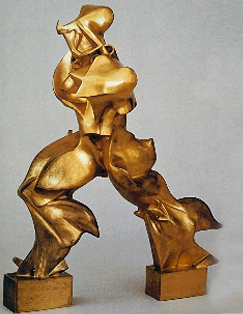 Umberto Boccioni, Formas unicas de continuidad en el espacio, 1913
Umberto Boccioni, Formas unicas de continuidad en el espacio, 1913
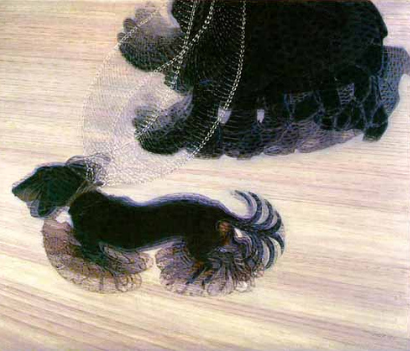 Giacomo Balla, Dinamismo de un perro con cadena, 1912
Giacomo Balla, Dinamismo de un perro con cadena, 1912
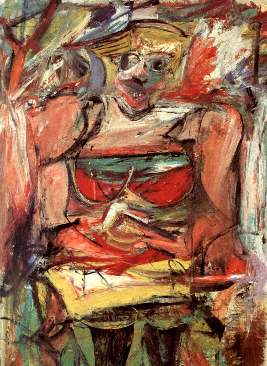 Willem de Kooning Mujer V, 1952-1953, National Gallery de Australia
Willem de Kooning Mujer V, 1952-1953, National Gallery de Australia
Movimientos: Futurismo; Vorticismo; Jinete Azul; Expresionismo Abstracto
FUTURISMO
El Manifiesto Futurista – 1909 - es el primer Manifiesto de la historia del arte, y da origen al Futurismo, movimiento creado por el artista Filippo Tommaso Marinetti. El Manifiesto Futurista fue publicado en diversos medios en Italia, pero su alcance internacional es cuando el diario Le Figaro lo publica en su portada. Por primera vez, un Manifiesto logra ser una noticia destacada en los medios franceses, cuna de los movimientos artísticos de la época.
El Futurismo clama y rinde tributo al nuevo mundo, a la industria, al auto, y proclama que la velocidad es la belleza contemporánea. Dejando atrás la historia, los museos, y el peso del pasado, el movimiento propone capturar en el arte el dinamismo y la energía del mundo moderno. Condenaban a los museos, a los que consideraban cementerios. Valoraban y pretendían la originalidad por encima de todo. Lo que proponían era un arte que celebrara el mundo moderno de la industria y la tecnología.
“Los museos: cementerios”
“ la nueva energía: el ruido y la velocidad de la vida moderna”.
El manifiesto dio origen a la pintura futurista y se extendió a todas las disciplinas: arquitectura, música, escultura, dibujo, fotografía, danza, teatro, etc., buscando representar el movimiento, el sonido estridente y la velocidad, pintando el mismo objeto sucesivamente en varias posiciones o borroneándolos, mostrando la fuerza del cambio, al límite con la abstracción.
Los principales artistas asociados al futurismo fueron Giacomo Balla, Umberto Boccioni, Gino Severini, Carlo Carrá.
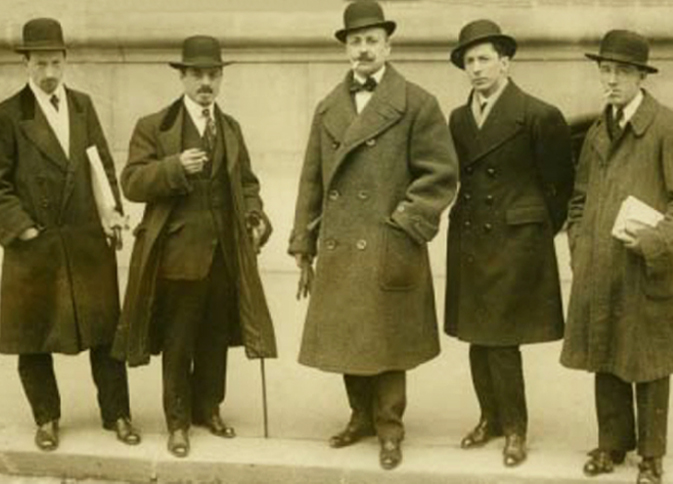
Russolo, Carrà, Marinetti, Boccioni y Severini en París, frente a Le Figaro. Febrero 1912
El pintor futurista Luigi Russolo, creador del ruidismo, considerado en la actualidad fundador de los nuevos conceptos de la música contemporánea. Russolo escribió el manifiesto “El arte de los ruidos” donde exaltaba la belleza del ruidismo urbano, de un automóvil a todo motor por la calle, sus bocina y el bullicio de la gente apurada en la ciudad.
 16.30.59.png)
Luigi Russolo y Ugo Platti con los antena-ruidos, 1921 / Recontrucción en Fundación Proa, 2009
VORTICISMO (1914)
El Vorticismo es el equivalente británico al futurismo, y afín al resto de las vanguardias, fundado en Londres, en 1914. Creado por el artista, escritor y polemista Wyndham Lewis editaron la revista BLAST (onomatopeya de explosión), con contenidos agresivos respecto de la tradición de la pintura, proponiendo la fragmentación cubista con imágenes afiladas que derivaban de la máquina y del ambiente urbano.
La Primera Guerra Mundial puso fin al Vorticismo. Los horrores de la guerra provocaron un rechazo de las vanguardias, en favor de enfoques más tradicionales y tranquilizadores de la creación artística, conocidos como “retorno al orden”.
JINETE AZUL (DER BLAUE REITER) - 1912
En 1911, Wassily Kandinsky y Franz Marc celebran en Munich la primera exposición de "Der Blaue Reiter". Esta fue una asociación informal donde también participaron Paul Klee y August Macke.
Posteriomente publicaron una colección de ensayos sobre arte moderno. El nombre del Jinete Azul es también la relación con la naturaleza, que se pueden apreciar en muchas de sus obras. La admiración por los caballos, y los jinetes, como así también la fascinación por el azul como color místico, dan cuenta de algunos pensamientos del grupo.
“Der Blaue Reiter”, llegó a su fin con la Primera Guerra Mundial en la que Macke y Marc fueron asesinados.
 16.39.02.png)
Franz Marc. Caballos azules, 1911
EXPRESIONISMO ABSTRACTO (1948)
El expresionismo abstracto es el término aplicado a las nuevas formas de arte abstracto desarrolladas por los pintores estadounidenses en las décadas de 1940 y 1950. Se propone concebir el arte abstracto, dejando la huella del gesto del artista en la pintura.
Los expresionistas abstractos se encontraban principalmente en la ciudad de Nueva York y se pueden observar dos grandes agrupaciones: los pintores de acción -que unían sus lienzos con pinceladas expresivas-, y los pintores que llenaban sus lienzos con formas abstractas y campos de color.
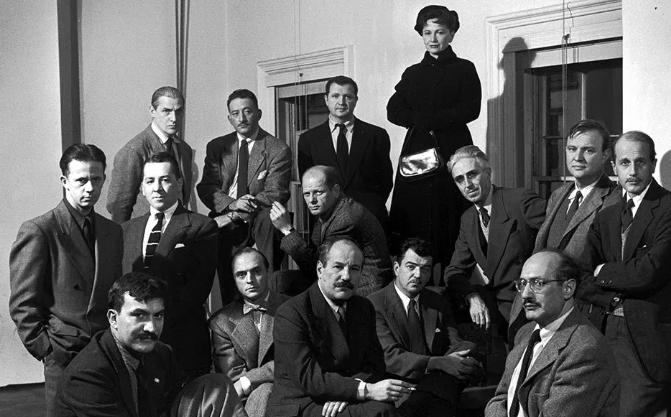 Fila inferior: Theodoros Stamos, Jimmy Ernst, Barnett Newman, James Brooks, Mark Rothko / Fila media: Richard Pousette-Dart, William Baziotes, Jackson Pollock, Clyfford Still, Robert Motherwell, Bradley Walker Tomlin / Fila superior: Willem de Kooning, Adolph Gottlieb, Ad Reinhardt, Hedda Sterne
Fila inferior: Theodoros Stamos, Jimmy Ernst, Barnett Newman, James Brooks, Mark Rothko / Fila media: Richard Pousette-Dart, William Baziotes, Jackson Pollock, Clyfford Still, Robert Motherwell, Bradley Walker Tomlin / Fila superior: Willem de Kooning, Adolph Gottlieb, Ad Reinhardt, Hedda Sterne
En este contexto, en 1948 Newman escribe “Lo sublime es ahora” en donde renueva en el siglo XX la categoría de “lo sublime” entendida como la sensación de pequeñez del hombre frente a la inmensidad de la Naturaleza.
 16.44.21.png) Barnett Newman en su estudio, 1952 /Foto Hans Namuth
Barnett Newman en su estudio, 1952 /Foto Hans Namuth
Es en Jackson Pollock y Willem de Kooning, donde el gesto pictórico queda documentado y el azar de la improvisación, la espontaneidad, es parte fundante de la obra.
Pollock colocaba su tela en el suelo y bailaba alrededor de ella tirando la pintura de la lata o arrastrándola con un pincel o un palo.
 16.46.38.png)
Jackson Pollock en su estudio, 1950
Pollock colocaba su tela en el suelo y bailaba alrededor de ella tirando la pintura de la lata o arrastrándola con un pincel o un palo.
Movimientos: Estridentismo; Creacionismo; Suprematismo
ESTRIDENTISMO (1921)
El Estridentismo es un movimiento mexicano multidisciplinario que buscó transformar las experiencias cotidianas de la vida moderna a través de performances, bromas y eventos absurdos. Surgido en plena Revolución Mexicana, el poeta Manuel Maples Arce redactó un manifiesto que proponía reinventar y revitalizar la vida cultural mexicana irrumpiendo con informalidad y esponteneidad para descontracturar la escena contemporánea, compartiendo características con las vanguardias europeas como el futurismo y el dadaísmo.
El manifiesto estridentista del poeta mexicano aparece por primera vez publicado en diciembre de 1921 en la revista Actual nº 1 en la Ciudad de México. Arce fue el fundador del movimiento.
CREACIONISMO (1922)
El poeta chileno Vicente Huidobro comienza con las ideas de una literatura despojada de historia, y concibe el Creacionismo, como una como "una teoría estética general”. Centrado en la poesía, el poema originario no debe alabar otra cosa, o para complacer al lector, ni siquiera para ser entendido por su propio autor. La poesía creacionista no requiere de rima, ni de ritmo sino que es un poema universal que puede ser comprendido en cualquier lugar y no requiere de su traducción.
Huidobro citó como inspiración algunos "poemas admirables" de Tristan Tzara, aunque su "creación" es más formal y fundamental, y también obras de Francis Picabia, Georges Ribemont Dessaignes, Paul Éluard y los poetas españoles Juan Larrea y Gerardo Diego.
We Must Create (Debemos crear) , 1922: El manifiesto del poeta chileno fue publicado por primera vez en francésen la colección Manifestes en 1925.
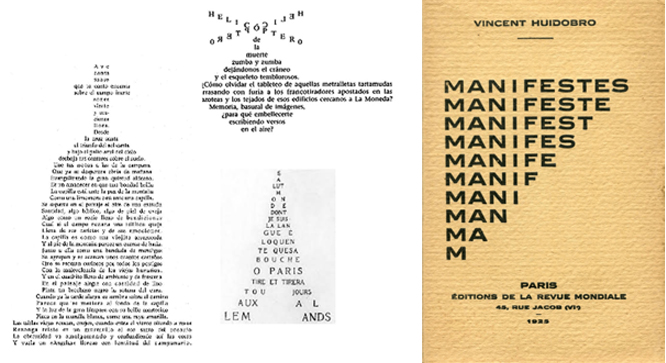
Caligramas y poesía visual de Huidobro
SUPREMATISMO (1915)
Suprematismo es el nombre dado por el artista ruso Kasimir Malevich en 1913, al nacimiento del arte abstracto caracterizado por formas geométricas básicas pintadas en una paleta limitada de colores. El Suprematismo proponía superar las formas del arte tradicional y promulgaba el acceso a la “pura sensibilidad suprema” eliminando los objetos de la pintura.
La primera exposición de pinturas suprematistas llamada 0.10 fue en diciembre de 1915 en Petrogrado. En esta muestra se presentó por primera vez la revolucionaria obra “cuadrado negro sobre fondo blanco”.
El movimiento Suprematista reunió artistas y disciplinas diversas. Las ideas se reflejaron en la arquitectura, en el teatro, en el vestuario, y en los diseños de objetos de la vida cotidiana.
Fundación Proa presentó en 2016, la primera retrospectiva del artista junto al Museo Estatal Ruso, donde se pudieron apreciar las revolucionarias pinturas y su trascendental influencia en el arte.
 16.58.50.png)
Exhibicion 0.10: Primera exposición donde se puede observar el cuadrado negro sobre fondo blanco. Estamos en presencia de obras sin objetos por primera vez en la historia del arte.
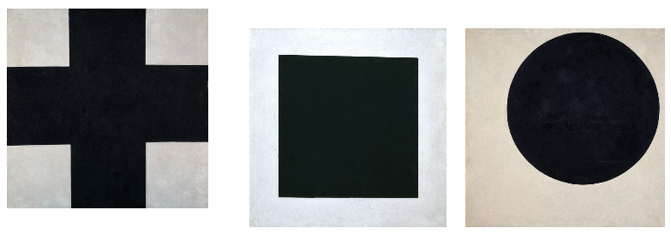
“Me he transfigurado en el cero de la forma y me he rescatado del lodazal de inmundicias de arte académico”
“Para la nueva cultura artística, los objetos se han desvanecido como humo, y el arte avanza hacia la creación como un fin en sí mismo y hacia el dominio de las formas de la naturaleza” (Malevich)
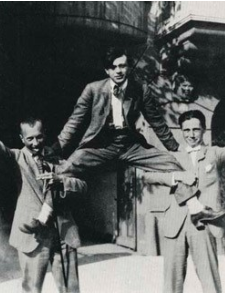 Jean Arp, Tristan Tzara y Hans Richter en Zurich, 1917
Jean Arp, Tristan Tzara y Hans Richter en Zurich, 1917
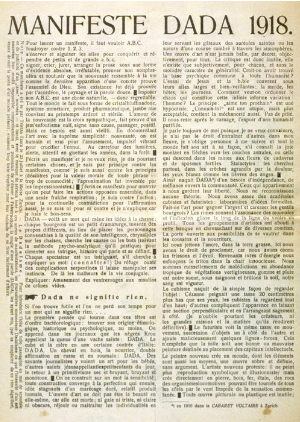 Dada Manifesto, 1918
Dada Manifesto, 1918
Movimientos: Dadaismo, Surrealismo, Espacialismo
Movimientos: Pop Art; Merz; Fluxus; Conceptualismo
POP ART (1962)
El Pop Art surge a mediados de los años 50 en Inglaterra, a fines de esa misma década en Estados Unidos, y alcanza su apogeo internacional en los años 60. Toma como fuente de inspiración la cultura popular y utiliza imágenes de los medios de comunicación, la publicidad, el cómic y la cultura de masas.
El POP manejó una iconografía muy reconocible extraída de anuncios publicitarios, historietas, objetos banales y domésticos, del mundo del cine y los medios de comunicación, pero también del “mundo común”: los supermercados, las hamburguesas, etc.
Algunos reconocidos artistas pop norteamericanos fueron Roy Litchestein, Claes Oldenburg y Andy Warhol; en Inglaterra, Peter Blake, Patrick Caulfield, Richard Hamilton, David Hockney, Allen Jones y Eduardo Paolozzi.
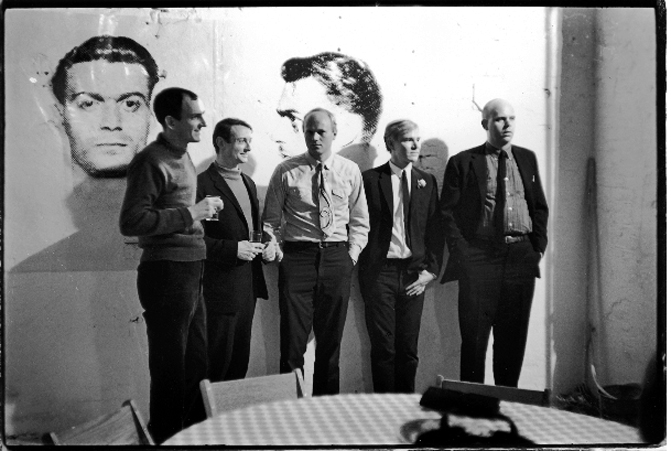
Tom Wesselman, Roy Lichtenstein, James Rosenquist, Andy Warhol, y Claes Oldenburg posando juntos en el loft de Warhol en Nueva York en 1964
«Los artistas pop hicieron imágenes que cualquiera que camine por Broadway podría reconocer en un segundo: cómics, mesas de picnic, pantalones de hombre, celebridades, cortinas de ducha, refrigeradores, botellas de coca cola. Todas las grandes cosas modernas de las que los expresionistas abstractos intentaron no dar cuenta en absoluto.» - Andy Warhol
Claes Oldenburg con sus obras de objetos cotidianos a escalas sobrehumanas y con materiales blandos, rechaza la tradición vigente hasta el momento y posiciona en el mundo artístico objetos como tortas, helados, raquetas de tenis, fideos, manzanas, entre otros objetos absurdos, como una forma de protestar contra los valores artísticos tradicionales.
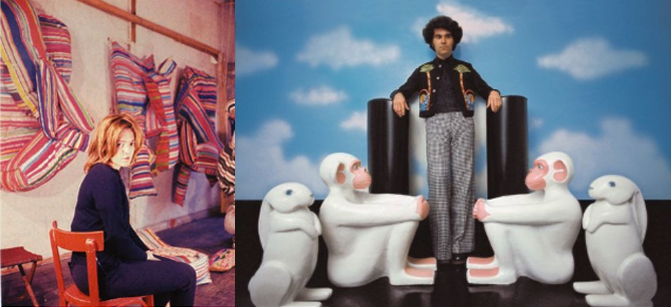
Marta Minujín y Edgardo Giménez, representantes del Pop en Argentina en los años 60.
Claes Oldenburg con sus obras de objetos cotidianos a escalas sobrehumanas y con materiales blandos, rechaza la tradición vigente hasta el momento y posiciona en el mundo artístico objetos como tortas, helados, raquetas de te
MERZ (1919)
Kurt Schwitters, máximo exponente del Dadaismo en Alemania, produjo hacia 1919 sus famosos collages y ensamblados con materiales de desecho en medio de la Guerra. Recortando azarosamente palabras de periódicos y publicidades para sus trabajos, Schwitters corta la marca del Commerz Bank y aparece la mítica palabra “nueva” MERZ que pasará a ser una suerte de unidad que describe diversas obras del artista. Más tarde, en 1933, en contexto de la Segunda Gran Guerra, construye sus conocidos edificios Merz o Merzbau, una estructuras monumentales dentro de su propia casa-taller que llenaba de grutas o túneles interconectados, dedicadas a los grandes artistas de vanguardia.
 17.57.05.png)
Merzbau, 1933. Estructuras conocidas como edificios Merz
FLUXUS (1963)
Fluxus es una agrupación internacional de artistas y compositores que se origina en la década de 1960 y continúa en la actualidad. Fluxus -en latín significa fluir- la fundó el artista lituano-americano George Maciunas, como una red internacional que unía artistas con diversos estilos que compartían la idea de explorar los límites del arte a través de la utilización de diversos medios y procesos para realizar puestas en escena, performances y acciones con cualquier material a mano de los artistas incluyendo mayormente su cuerpo, para su obra de arte.
Fluxus tuvo un papel central en el desarrollo del arte performático, en tanto manifestación o acción artística frente un público en la que, a diferencia de las interpretaciones teatrales, no hay diálogos previamente fijados por escrito y, generalmente, los factores de improvisación y provocación o asombro desempeñan un rol principal.
Los principales centros de actividad de Fluxus fueron Nueva York, Alemania y Japón y los artistas más destacados son Joseph Beuys, Dick Higgins, Alice Hutchins, Yoko Ono, Nam June Paik, Ben Vautier, Robert Watts, Benjamin Patterson, Alison Knowles, Dick Higgins y Emmett Williams.
John Cage es uno de los artistas que mejor da cuenta de la intensidad de las propuestas de la agrupación. Sus composiciones musicales son representativas de la problemática artística de la segunda mitad del siglo XX. Las obras abstractas realizadas con un cactus o el silencio cargado de presencia son algunos de los conceptos de su música.
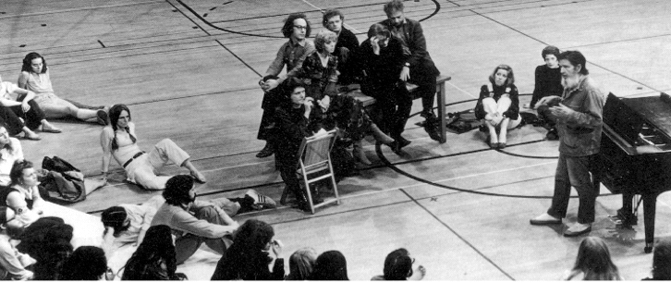
John Cage comentando su obra 4’33’’ en Berlín, 1952
“Fluxus es antes que todo un estado de ánimo, un modo de vida impregnado de una soberbia libertad de pensar, de expresar y de elegir. De cierta manera Fluxus nunca existió, no sabemos cuando nació, luego no hay razón para que termine.” (George Maciunas)
Fomentaban las colaboraciones entre artistas y entre distintas formas de arte, así como la interacción con el público. Valoraban la sencillez y el anti-comercialismo, y en la creación de obras el azar y el humor desempeñaban un papel importante.
CONCEPTUALISMO (1967)
El arte conceptual surgió a mediados de los años 60 reuniendo a las manifestaciones artísticas en las que la idea y los conceptos son el cuerpo de la obra. El conceptualismo se extendió internacionalmente y simultáneamente en Europa, América del Norte y América del Sur hasta mediados de la década del 70.
Adhirieron a ella numerosos artistas que eligen distanciarse de la noción histórica de obra de arte única, dado que los artistas conciben las ideas y la ejecución de la misma puede estar realizada por otros. El arte conceptual es también una rebelión al mercado del arte muy estimulado con las obras de arte POP.
Los orígenes y las influencias del arte conceptual llegan más allá de estas dos décadas. Marcel Duchamp es muchas veces considerado “padre” de esta tendencia y su obra Fuente es citada como la primera obra de arte conceptual.
Algunos de los artistas principales asociados con el movimiento conceptual del arte son: Arte y lengua, John Baldessari, Joseph Beuys, Marcel Broodthaers, Victor Burgin, Michael Craig-Martín, Gilbert and George, Mary Kelly, Yves Klein, Joseph Kosuth, John Latham, Richard Long y Piero Manzoni.
Sol LeWitt, uno de los padres fundadores del arte conceptual norteamericano,
escribió y publicó en 1969 su Manifiesto, a modo de decálogo para el arte conceptual, 35 pensamientos críticos sobre los que el mismo advierte: “Estas frases son comentarios sobre arte, pero no son arte“:
Las ideas pueden ser obras de arte
Una vez que la idea de la obra se establece en la mente del artista y su forma final es decidida, el proceso se lleva a cabo a ciegas.
Las ideas banales no pueden salvarse mediante bellas ejecuciones.
Los artistas conceptuales trabajan con ideas generalmente monumentales. Richard Long diseña sus obras en la naturaleza.
Sol Lewitt es el fundador de los Wall Drawings, pintura mural de figuras geométricas y abstractas a gran escala, el diseño son instrucciones ejecutadas por un equipo de asistentes. En el año 2001 Sol Lewitt ejecutó seis Wall Drawings en Fundación Proa.
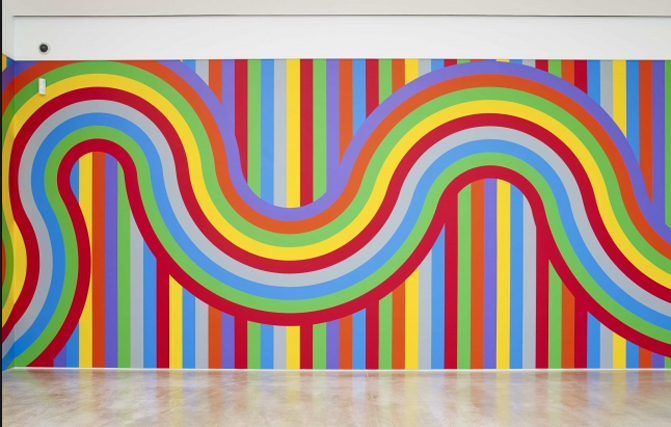
Sol LeWitt, Wall Drawing #1136, London, 2013
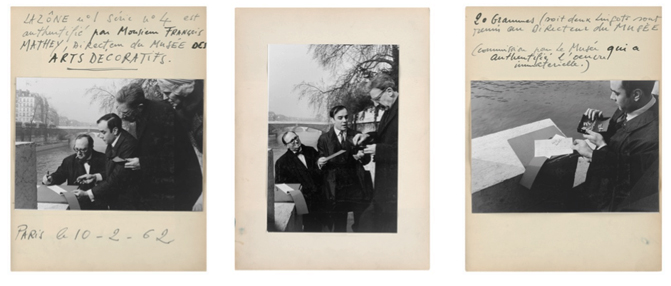
Yves Klein. Transferencia de una Zona de sensibilidad pictórica inmaterial al Sr. Blanckfort, París, 10 de febrero, 1962